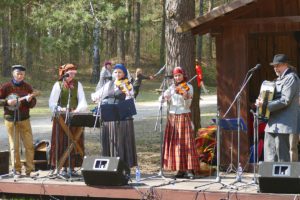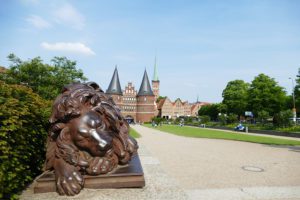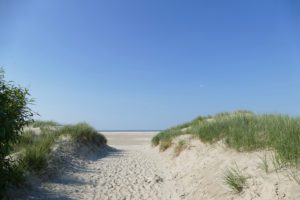Lithuania might be small, but it’s steeped in history, innovation, and full of natural wonders, and its capital, Vilnius, effortlessly blends its rich traditions with modernity. But that’s by far not the only reason that makes the city an exceptionally exciting travel destination. Therefore, after having already featured the best places in the other Baltic Republics, it was finally time to see on a long weekend what Vilnius has in store.
And let me assure you: the so-called Baroque Pearl of the Baltic is an incredibly lustrous gem!

Better Late Than Never
Those, let’s call them, unconventional flight times from airBaltic are a bit annoying. From my home airport, you have two extremes to choose from: either you fly before the first cockcrow, or you’re one of the last passengers of the day to go through security because you’re taking the second-to-last flight that day. The last one, by the way, goes to Mallorca.
With this second-to-last flight, you then land in Vilnius at midnight, only to find that it’s an hour later there. After all, the Baltic republics are located in the far east of Europe. But as the cab drops me off in the softly lit square in front of the hotel, the city is bathed in an unreal light, and I feel like I’m in another world. An atmosphere like from a different past, and yes, a better time.
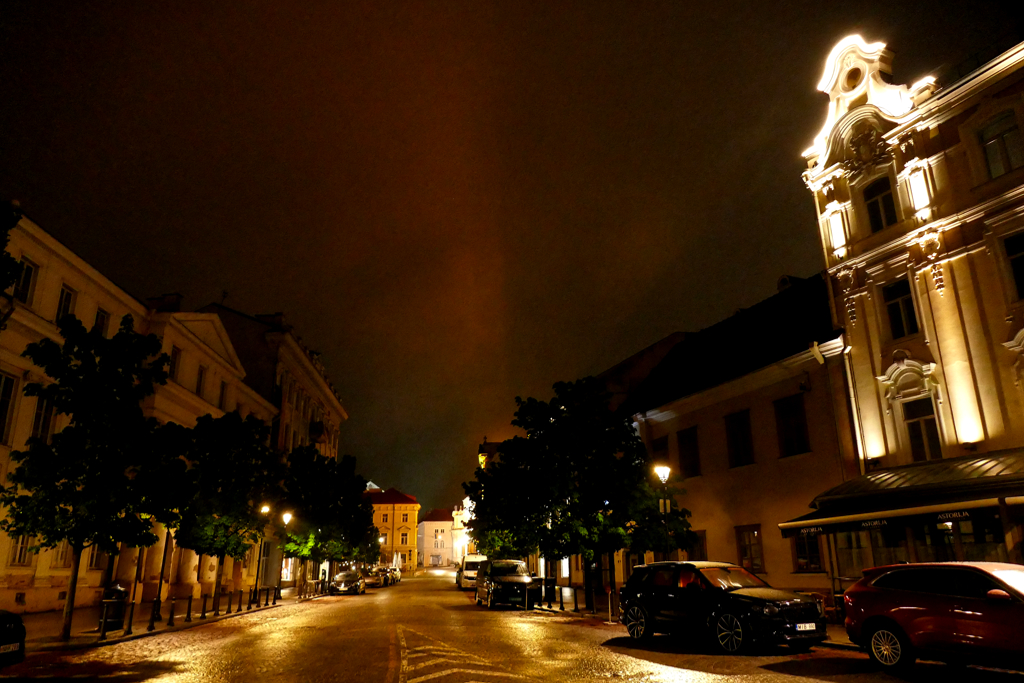
My hotel is directly across from the Church of St. Casimir and is also bathed in luminous yet warm light. By now, it’s two a.m., and on the one hand, I’m dead-tired. On the other hand, this atmosphere is so inspiring. It feels like Vilnius belongs to me alone. I’d really like to relish this moment a little longer and not go to bed just yet. But I have to be reasonable. After all, I have a lot planned for the next few days in this marvelous city, so I should be well-rested.
One last look at this magical scenery, and then, somewhat wistfully, I take the elevator to the fifth floor of the luxurious Radisson Collection Astorija Hotel*, which will be my home away from home for the next three nights.
Vilnius, the Baroque Pearl of the Baltic
Since Vilnius still seems to be quite a hidden gem in Europe’s treasure chest, let’s start with a short introduction. Vilnius has overcome many challenges in its past and has continued to evolve. The city looks back at a history characterized by cultural diversity, prosperity, and political upheaval. What hardly anyone seems to remember today: Lithuania was once one of the largest countries in Europe when it formed the Grand Duchy of Lithuania in the Middle Ages. This empire stretched to the Black Sea and had a profound influence on European history.
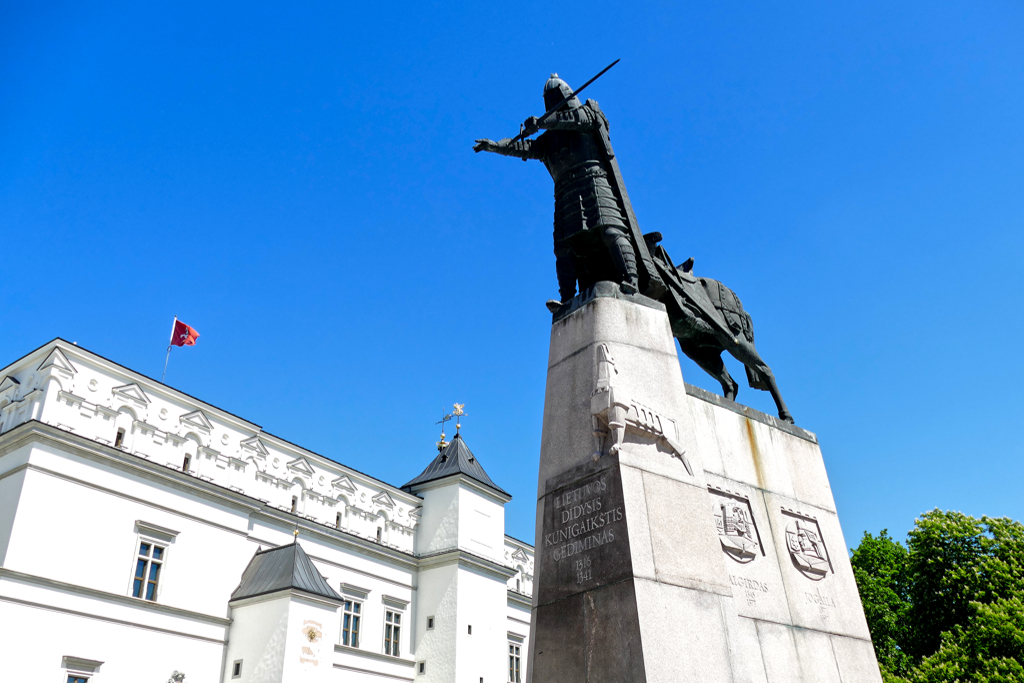
In the 14th century, Grand Duke Gediminas invited traders and artisans from all over Europe to settle in Vilnius. This led to the city’s multicultural growth. Hence, in the 15th and 16th centuries, the city experienced its first great period of prosperity. Vilnius became the political and cultural center of the Grand Duchy of Lithuania, one of the largest states in Europe.

Renaissance and Baroque buildings shaped the cityscape, and in 1579, one of the oldest universities in Eastern Europe was founded right in the heart of Vilnius.
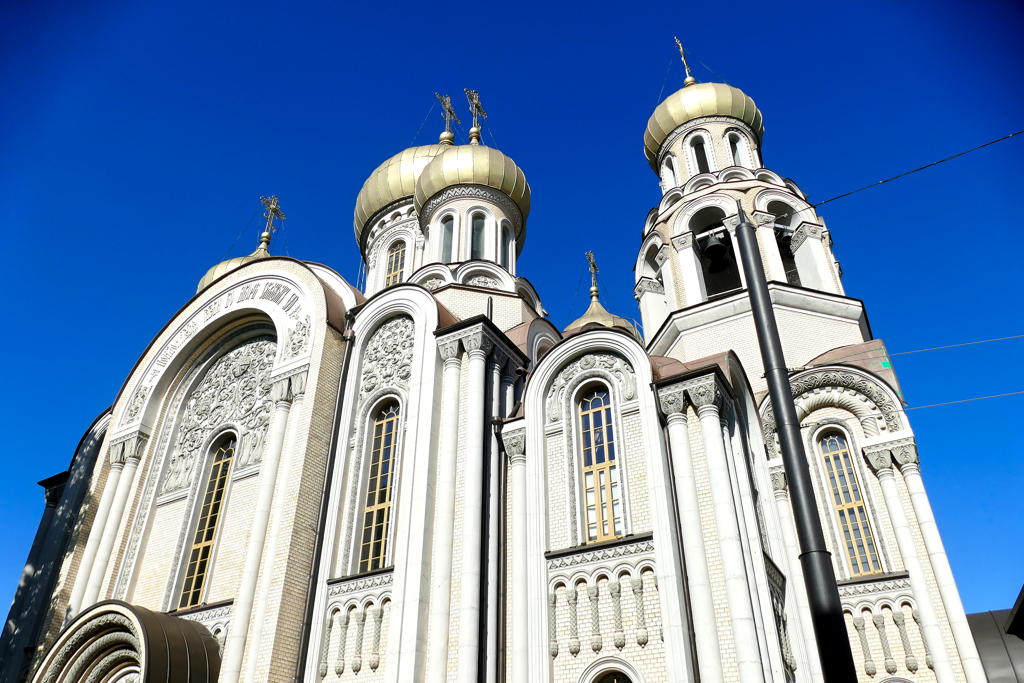
Then, in the 17th century, turbulent times began. The city was completely devastated in the Swedish-Polish War, and in the 18th century, Vilnius fell under Russian rule due to the partitions of Poland and Lithuania. Russification continued in the 19th century as the university was closed in 1832, and Polish and Lithuanian cultural assets were suppressed.
From Fall to Freedom
It wasn’t until after the First World War that Lithuania was able to declare its independence in 1918. However, Vilnius was occupied by Poland and remained part of it until 1939. That year, following the Hitler-Stalin Pact, the city was annexed first by the Soviet Union and then by Nazi Germany.
After World War II, Vilnius ultimately fell to the Soviet Union. During this occupation, many Lithuanians were repressed or deported.
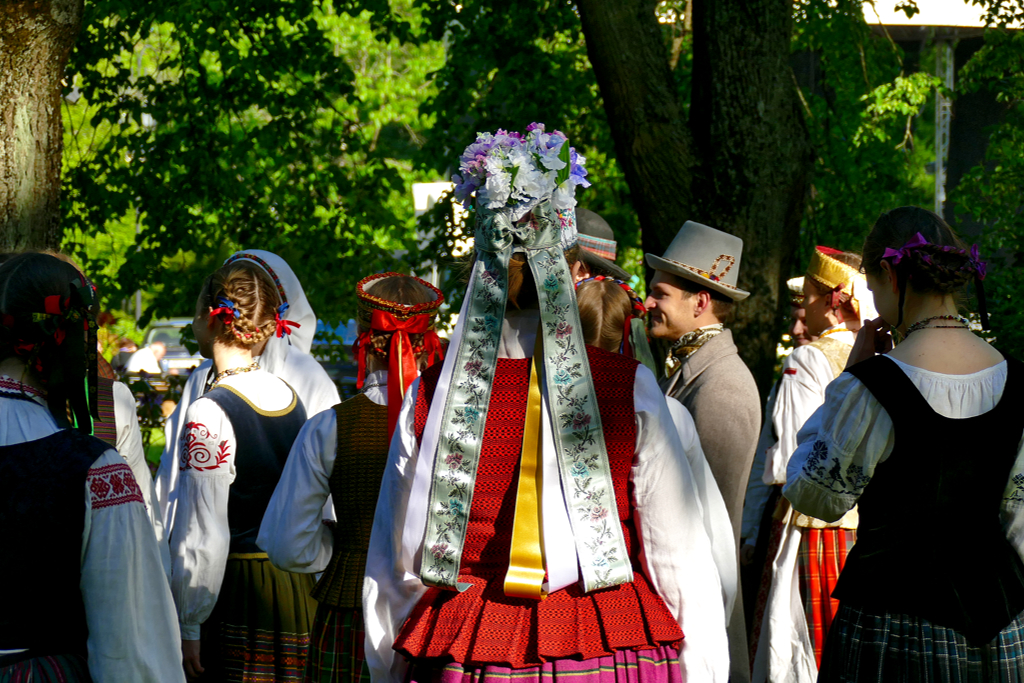
Historic buildings were destroyed or left to decay. Nevertheless, Vilnius remained a center of Lithuanian culture and resistance, and with the collapse of the Soviet Union, Lithuania became the first country in the former USSR to declare its independence in 1990, with Vilnius as its capital. The so-called Singing Revolution and the Baltic Chain, a 600-km-long human chain from Vilnius to Tallinn, are just two examples of the country’s strong desire for freedom.
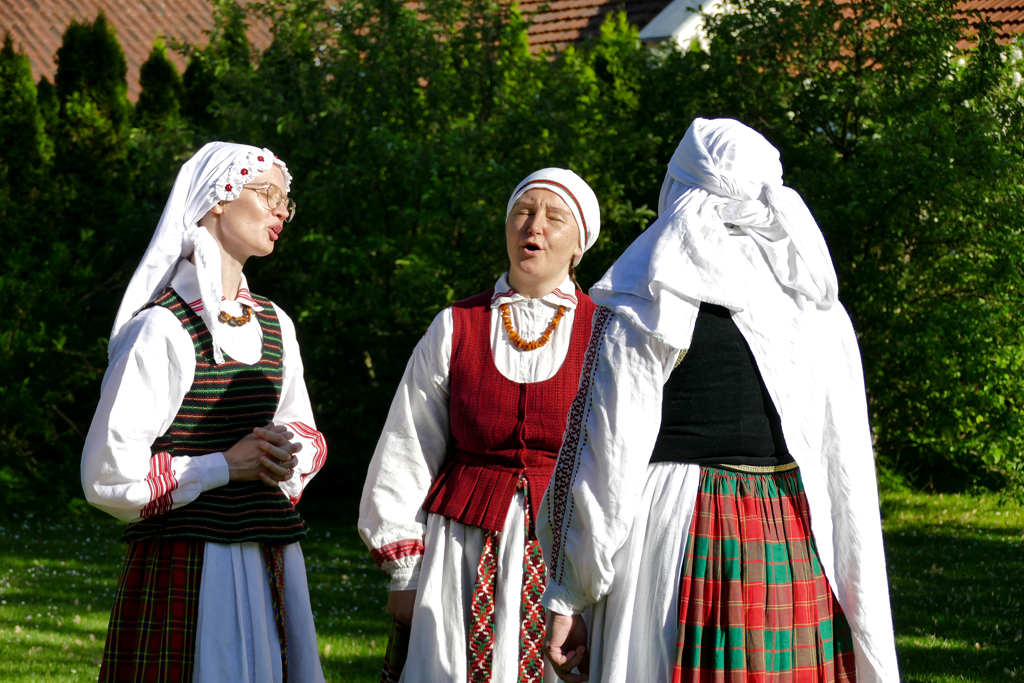
While in the Baltics, Riga is known for its Art Nouveau and Tallinn for its medieval old town, Vilnius impresses with its Baroque architecture. The city has a rich culture with Polish, Jewish, and Lithuanian influences. In 1994, Vilnius’ old town was recognized as a UNESCO World Heritage Site.
What to See in Vilnius on an Unforgettable Weekend
So yes, all these cultural tourists come to Vilnius to admire the incredible architecture and cultural significance of over 50 churches, many of which were built in the Baroque style. That’s understandable, and I’ve dedicated a separate post to the most important of these magnificent structures to do them justice.

However, during my visit, I didn’t know where to look first, what to see next. The cute little café, where only the finest artisan roasts are served in a unique setting? The fascinating contemporary art museum, housed in a building designed by none other than Daniel Libeskind, the American-Polish star architect? Or would you rather listen to the traditional singing groups in the lush Bernardine Garden? Climb the Gediminas Tower to get the big picture? Or perhaps gain atmospheric insights into hidden gateways and backyards? Walk in the footsteps of past Jewish life in the former Glass Quarter or tour the free Republic of Užupis?
Man, a long weekend is hardly enough to get to know everything Vilnius has to offer. But we have to start somewhere, and the best place to commence is where it once all began.
Castle, Cathedral & Co.
Just as every first-time traveller to Paris pays a visit to Notre Dame and hardly any sightseer misses St. Peter’s Basilica in Rome – or more precisely in Vatican City – every newbie to Vilnius will stroll across the Cathedral Square. And very rightly so, since this is where some of the most important historical sites are located.
Created as a public square following the transformation of Vilnius into a Christian and later Baroque city, the Cathedral Square continues being the city’s central meeting place and urban heart.
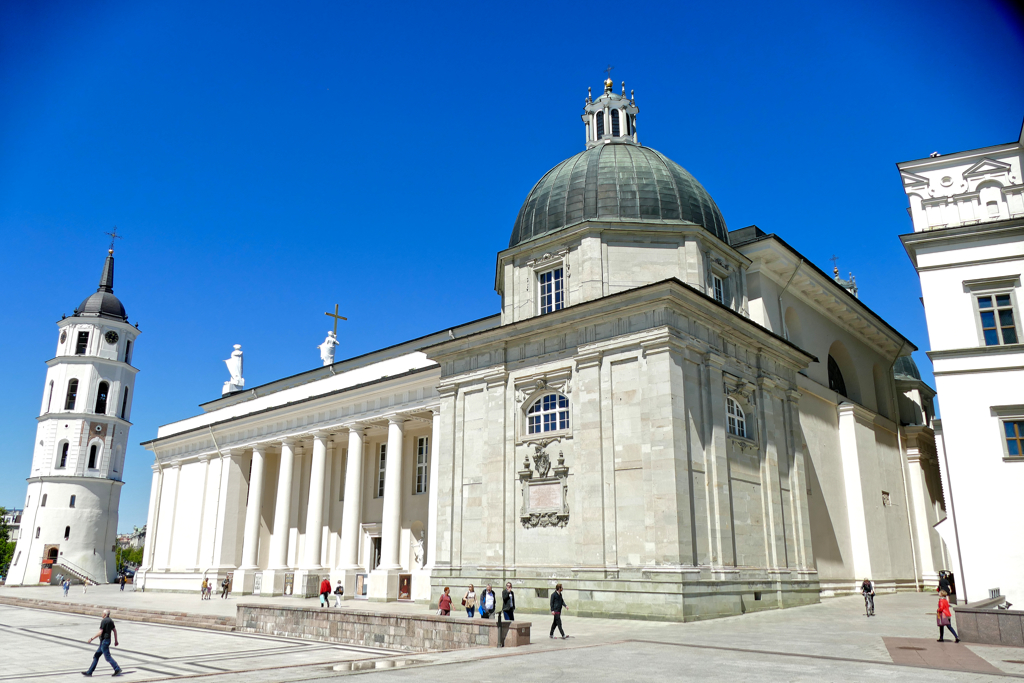
It has always been used for public gatherings and religious festivals. During the times of the Grand Duchy and the Russian Empire, proclamations were announced here. However, the square was also a place of public justice. During the Tsarist regime in the 19th century, particularly after the November and January uprisings against Russian rule, executions took place to demonstrate power and control.
Public executions at that time served not only as punishment but also to intimidate the population.
Extensive redesigns took place in the 19th and 20th centuries, shaping the square as it is today.
In addition to the bell tower, which was originally part of the city wall, the Stebuklas tile is a particularly treasured symbol. It commemorates the human chain formed by the three Baltic republics in 1989, which marked the beginning of the end of Soviet rule in the Baltics.
The Baltic Chain
This episode in the recent history of the Baltic republics deserves a somewhat more detailed explanation.
On August 23, 1989, around two million people from Lithuania, Latvia, and Estonia joined forces to form a 600-kilometer-long human chain from Vilnius via Riga to Tallinn. This peaceful demonstration, known as the Baltic Way or Baltic Chain, was a groundbreaking protest against Soviet occupation and a call for the independence of the Baltic states.
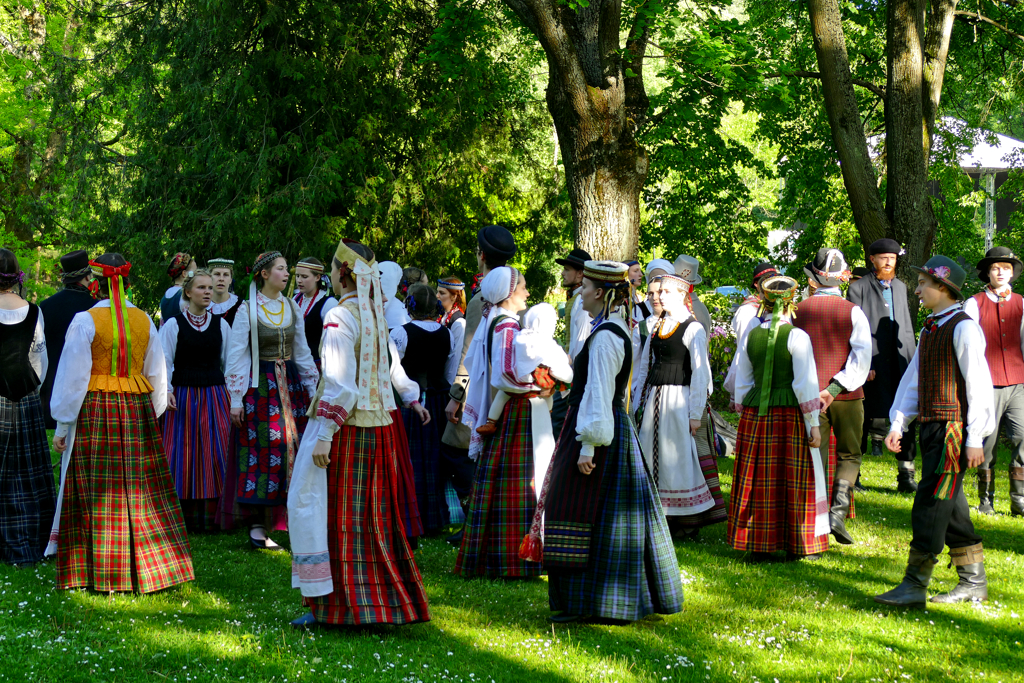
Initiated by the Sąjūdis Movement, Lithuania’s reformist and independent organization, the chain began at the Cathedral Square in Vilnius as the southernmost spot. Also, the peaceful protest coincided with the 50th anniversary of the 1939 Molotov-Ribbentrop Pact, which led to the secret Soviet-Nazi agreement to divide Eastern Europe. A pact that led to the annexation of Lithuania by the USSR in 1940.
Ultimately, the movement led to Lithuania’s declaration of independence on March 11, 1990. Lithuania was the first former Soviet republic to secede from the Soviet Union.
The event was, very deservedly, added to the UNESCO Memory of the World Register in 2009.
Vilnius Cathedral
The Cathedral of St. Stanislaus and Ladislaus, or Vilnius Cathedral for short, was originally built after the Christianization of Lithuania in 1387 by order of King Władysław II Jagiełło, probably on the site of a pagan temple dedicated to Perkūnas, the Baltic god of thunder.
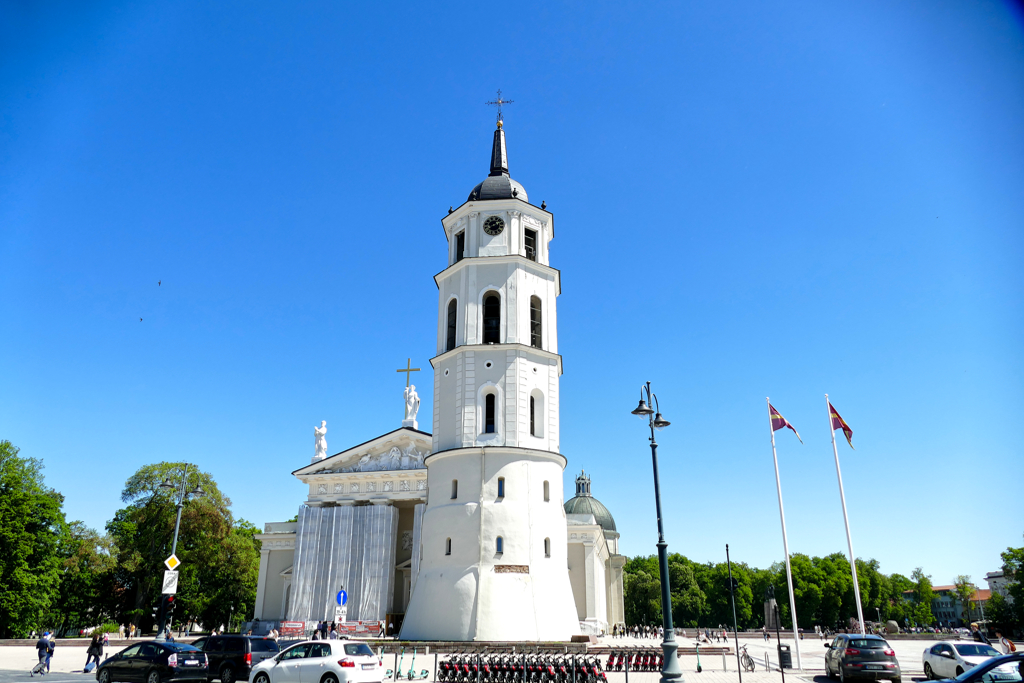
Over the centuries, it was rebuilt several times due to fires and wars.
A late Gothic style was favored at the beginning of the 15th century, while a Renaissance touch-up was added in the 16th century. Baroque additions followed in the 17th century. The Neoclassical style followed at the end of the 18th century. Thus, the cathedral beautifully echoes the architectural eras that Vilnius has undergone.
In addition to the final resting places of several bishops and noblemen, the cathedral also houses the tombs of Saint Casimir, whose chapel is a masterpiece of the early Baroque, as well as King Alexander Jagiellon of Poland and Vytautas the Great, a ruler of the Grand Duchy of Lithuania.
Palace of the Grand Dukes of Lithuania
Next to the Cathedral stands the imposing Palace of the Grand Dukes of Lithuania. Its construction began in the 15th century during the rule of Grand Duke Vytautas the Great. Sigismund the Old expanded in the early 16th century. The palace became the political, administrative, and cultural center of the Grand Duchy of Lithuania and later the Polish–Lithuanian Commonwealth. It also functioned as the residence for Lithuanian rulers until the mid-17th century.
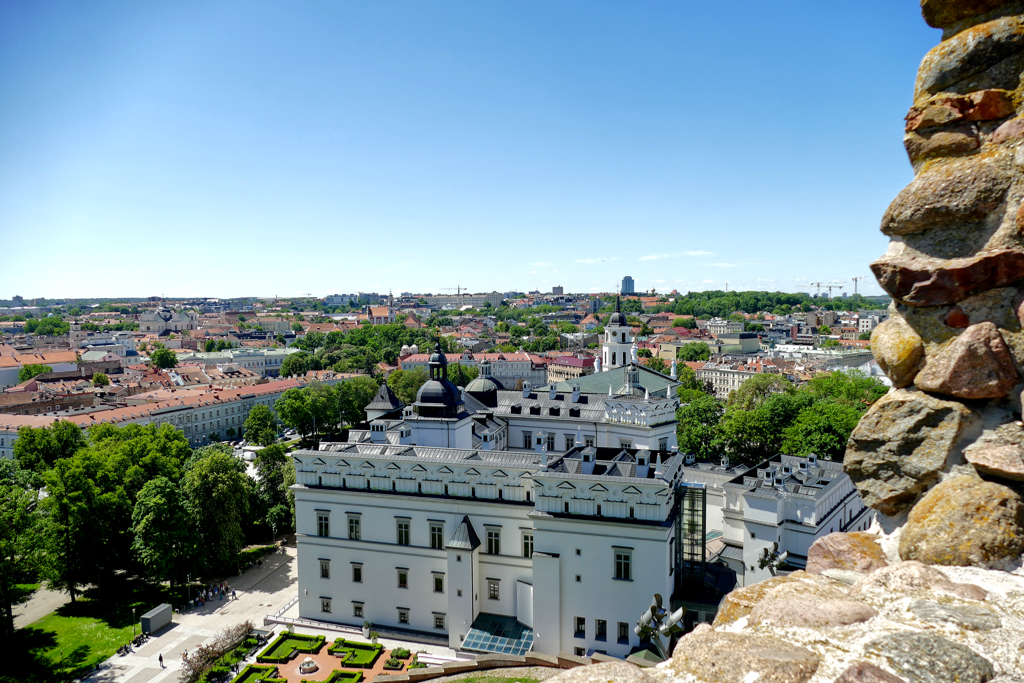
However, during the Russo-Polish War, the palace was severely damaged in 1655, and when Vilnius was under Tsarist control, it was completely demolished in the early 1800s. Reconstruction began only in 2002, and the palace was reopened to the public in 2009.
Today, it houses a cultural center and a museum, which includes authentic archaeological remains, reconstructions of the Renaissance and early Baroque interiors, and exhibitions on Lithuanian statehood, diplomacy, and art.
Visiting hours for the palace vary depending on the month and day of the week, from 10 a.m. to 6 p.m. to 8 p.m. The palace is closed on Mondays. Admission prices for various tours range from 4 €uros to 8 €uros each; a combination ticket for 16 €uros allows you to visit all areas. The Palace of the Grand Dukes of Lithuania is, of course, included in the Vilnius Pass*.
New Arsenal
As you walk around the Cathedral to get to the Gediminas Tower, you’ll pass the Naujasis Arsenalas. This New Arsenal is a historic building that currently houses one part of the National Museum of Lithuania. Its origins trace back to the 16th century, when it served as a residence for Grand Duke Žygimantas Augustas. According to legend, he commissioned this luxurious dwelling, complete with gardens and swan-filled ponds, to court his future wife, Barbora Radvilaitė.
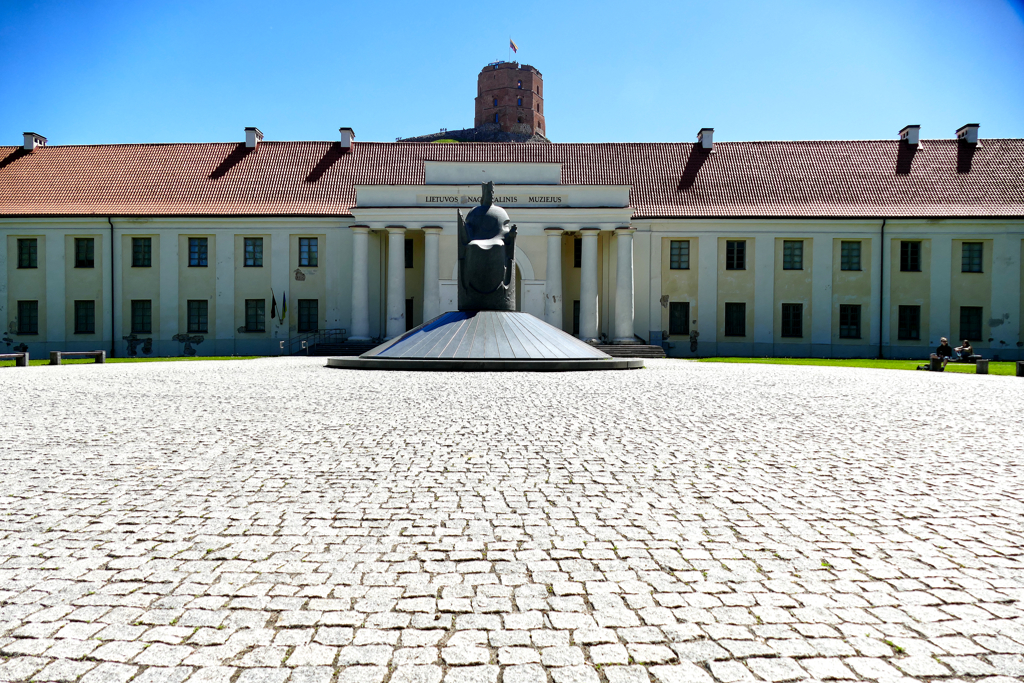
In the 20th century, the New Arsenal became a central exhibition space for the National Museum of Lithuania, showcasing artifacts from the 13th century through the early 20th century. The museum’s exhibits encompass various departments, including history, archaeology, ethnography, numismatics, and iconography, which are distributed in venues all over the city.
However, since 2023, the New Arsenal has been temporarily closed for reconstruction.
Gediminas Tower And Hill
The Gediminas Tower on the eponymous hill towers above all this history and splendor. Grand Duke Gediminas commissioned the Upper Castle in the early 14th century. His descendants then had the complex expanded. Its strategic location on a hill overlooking the Neris River made it an important defensive site.
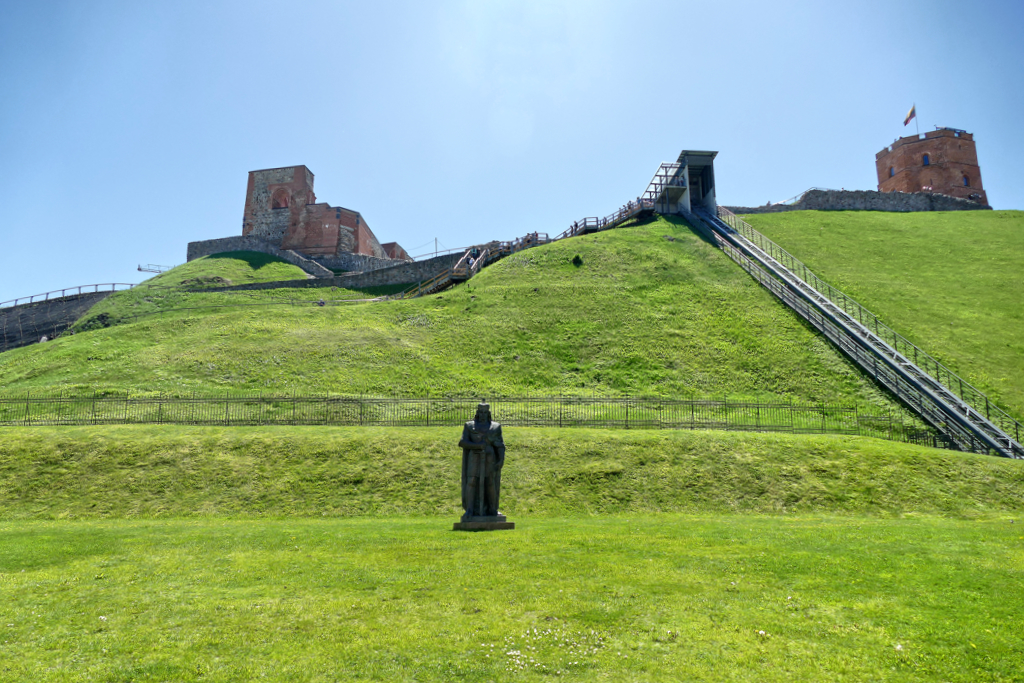
Grand Duke Vytautas then commissioned the brick tower, which still stands today, in the 15th century.
The Vilnius Castle complex consists of the Upper, Lower, and so-called Crooked Artillery Castles. Together with the Grand Dukes’ Palace, it was plundered and damaged during the Muscovite invasion of 1655. In the 19th century, it was used by the Russian military and subsequently abandoned.
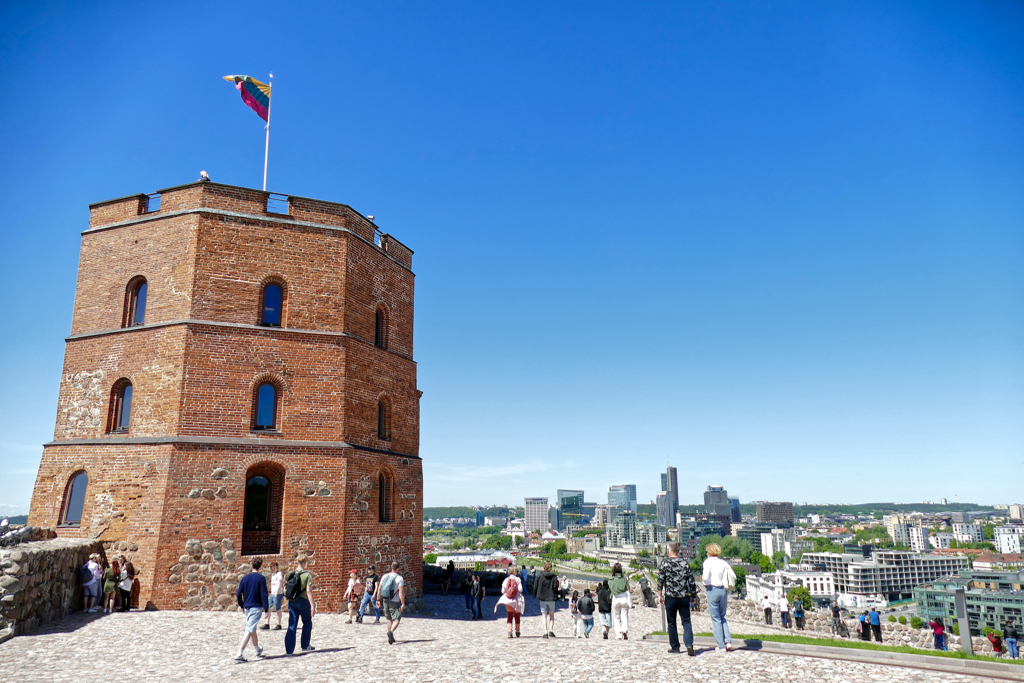
Today, the Gediminas Tower is considered a national symbol and even adorns the Lithuanian €uro cent coins. It houses a museum with models of medieval Vilnius and exhibits on the castle fortifications. While the entire area on the mountain platform offers beautiful panoramic views of the city, the view from the roof of the tower is breathtaking.
The tower is open daily from 10 a.m. to 8 p.m. The entrance fee is 8 €uros, but you have free access with the Vilnius Pass*.
To get to the top of the hill, you can either take a hiking trail or climb the stairs. If, for whatever reason, you don’t want to walk, you can take the very inexpensive funicular. A one-way ride costs 2 €uros, and a return trip costs 3 €uros. Considering you’ll probably be doing a lot of walking, this is a nice way to save at least a few steps.
Hill of Three Crosses
If you also want to visit the Hill of Three Crosses, you have no choice but to lace up your hiking boots. The Hill of Three Crosses is located in Kalnai Park northeast of the old town, in close proximity to Gediminas Hill, and is a place of strong symbolic, religious, and historical significance for Lithuania.
The site is originally linked to an ancient legend from the 14th century. Allegedly, seven Franciscan monks were crucified here and murdered by pagans while attempting to Christianize Lithuania. Although this story is not historically verified, it has become a religious narrative linking the site to Christian martyrdom.
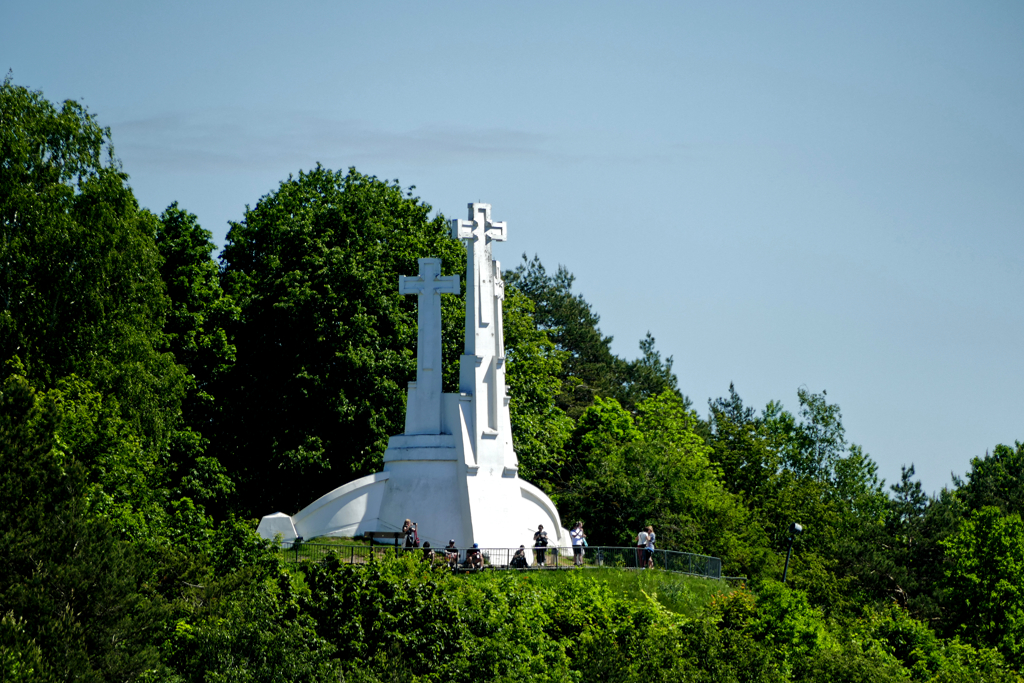
The first wooden crosses were probably erected by Bernardine monks in the 17th century.
As the wooden crosses continually deteriorated over time, they were replaced several times.
During the Soviet occupation, the crosses were blown up by the authorities in 1950 because they were considered a symbol of religious resistance and Lithuania’s national identity. However, the site remained a silent symbol of resistance to the regime for the people. It’s no wonder, then, that a new memorial was erected after the independence movement.
Thus, the Hill of Three Crosses is now a place of pilgrimage, a national memorial to the victims of persecution, but also a popular viewing point for visitors.
Pilies Gatvė And Its Side Alleys
What is immediately noticeable in Vilnius is that the city is not annoyingly overrun with tourists. This means that there is never that Disneyland vibe that other European metropolises sometimes degenerate into or are reduced to by visitors.

In Vilnius, there is a healthy mix of locals and visitors everywhere. The irrelevant exception is restaurants that serve the famous national potato-focused cuisine.
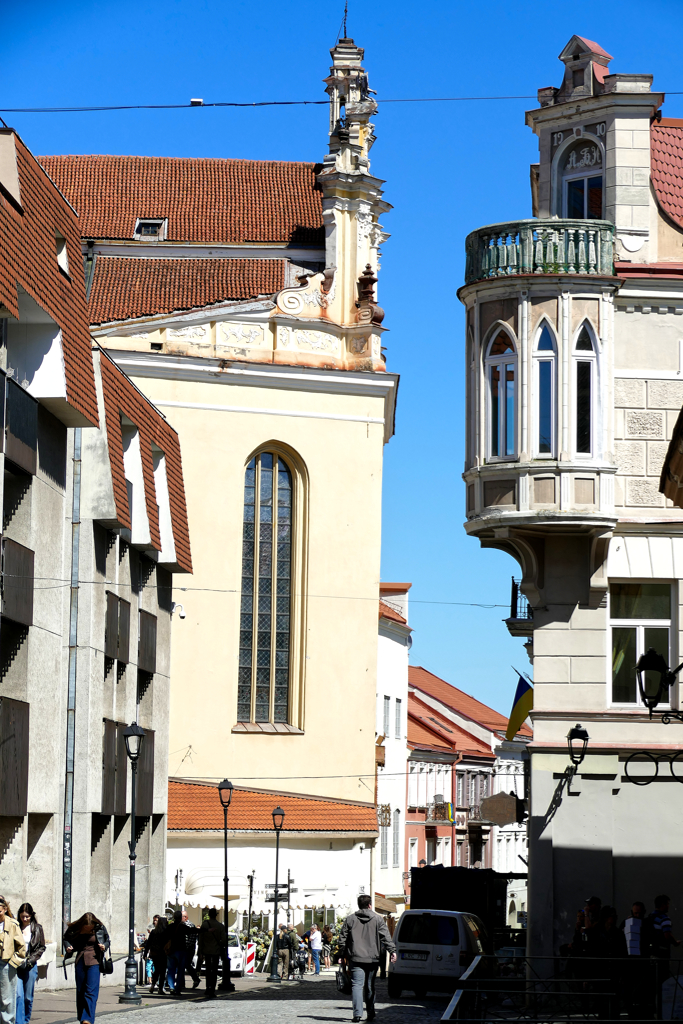
“Why should I eat traditional food at a restaurant? I can get these meals from my mother or grandmother whenever I want. I don’t have to go to a restaurant,” explains a young Lithuanian woman. Yes, she certainly has a point there. Everyone else who doesn’t have a Lithuanian mother or grandmother meets, for example, in the atmospheric cellar bars along Pilies Gatvė.
Pilies Gatvė, which means Castle Street in English, is one of the oldest, most famous, and historically significant streets in Vilnius’s old town. It connects the Cathedral Square with the Town Hall Square.
Vilnius Main Artery
As early as the 14th century, Pilies Gatvė was the main access route to the Upper Castle on Gediminas Hill. In the Middle Ages, it was part of an important trade route between Vilnius and Central Europe. Merchants, artisans, and noblemen lived here and made it the scene of many historical events such as processions, political rallies, and religious festivals.
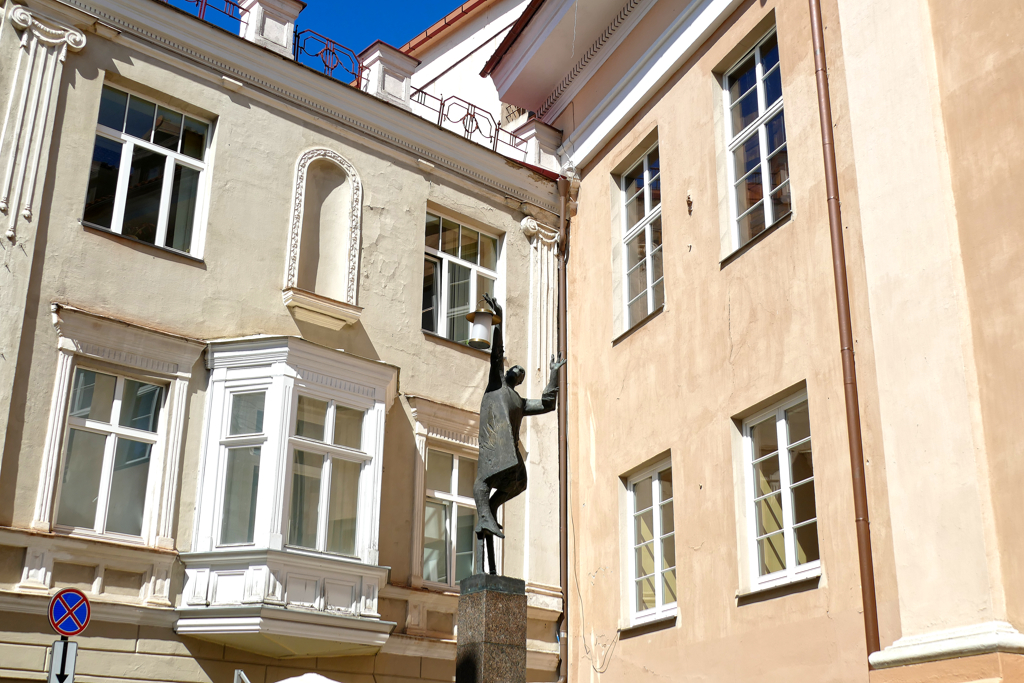
The magnificent townhouses along the street display a mix of architectural styles, including Gothic, Renaissance, Baroque, and Neoclassical, and bear witness to the wealth and cultural influence of past centuries. Many of these buildings are now listed as historical monuments.
Although Pilies Gatvė is one of the most popular streets in Vilnius, it is not a tourist trap. It has a very cozy atmosphere. Here you can browse for amber, linen products, and traditional handicrafts in cute little souvenir shops, or take a break in one of the city’s oldest cafés.
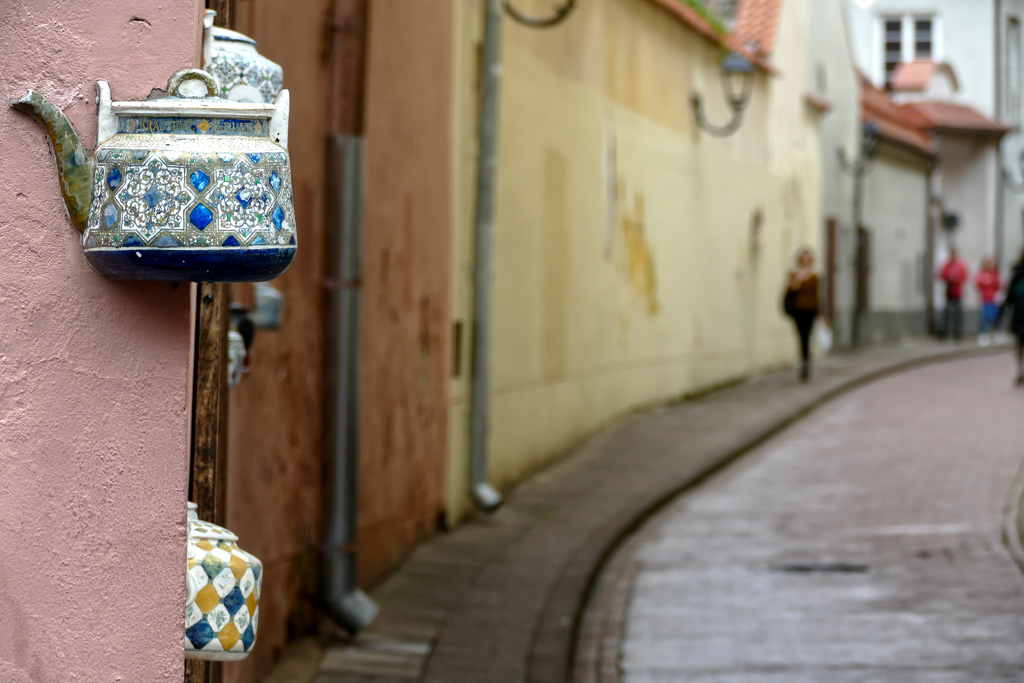
To the right and left of Pilies Gatvė are important sights such as St. Anne’s Church and Vilnius University with its famous St. John’s Bell Tower. But I especially recommend exploring the charming side streets, where life immediately slows down.
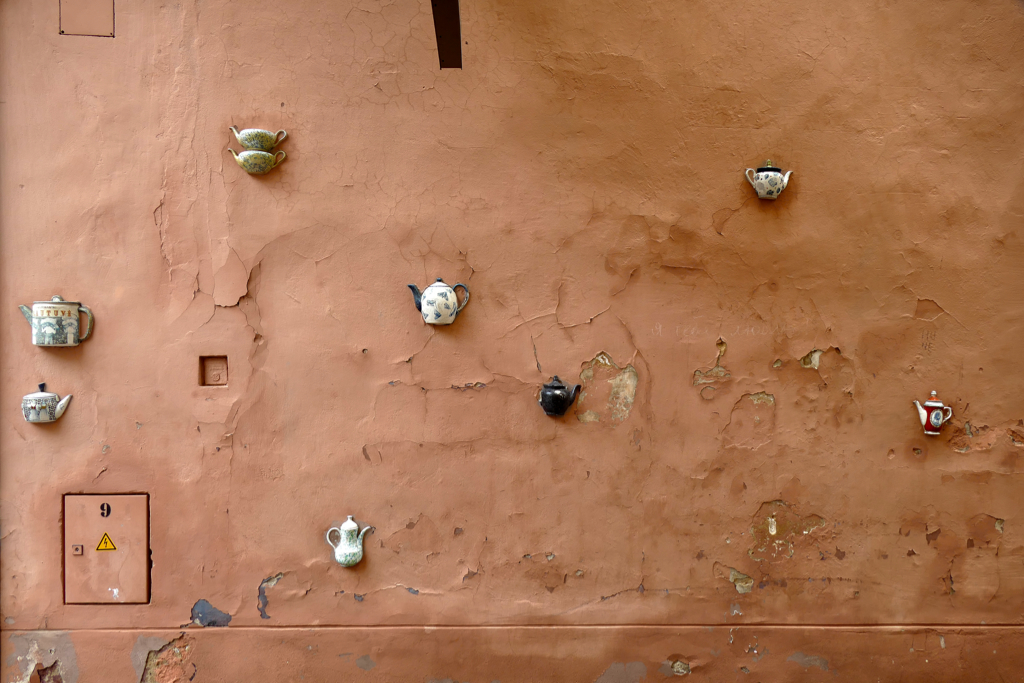
It’s secluded and quiet here, but be sure to keep your eyes open so you don’t miss any of the charming details. Lithuanians are world champions at enchanting street decoration, and they prove this especially around Pilies Gatvė.
Literatų Gatvė, the Literature Lane
Literatų Gatvė is one of the city’s most charming and symbolic streets. It is a unique open-air art project dedicated to literature and its authors with a connection to Lithuania.
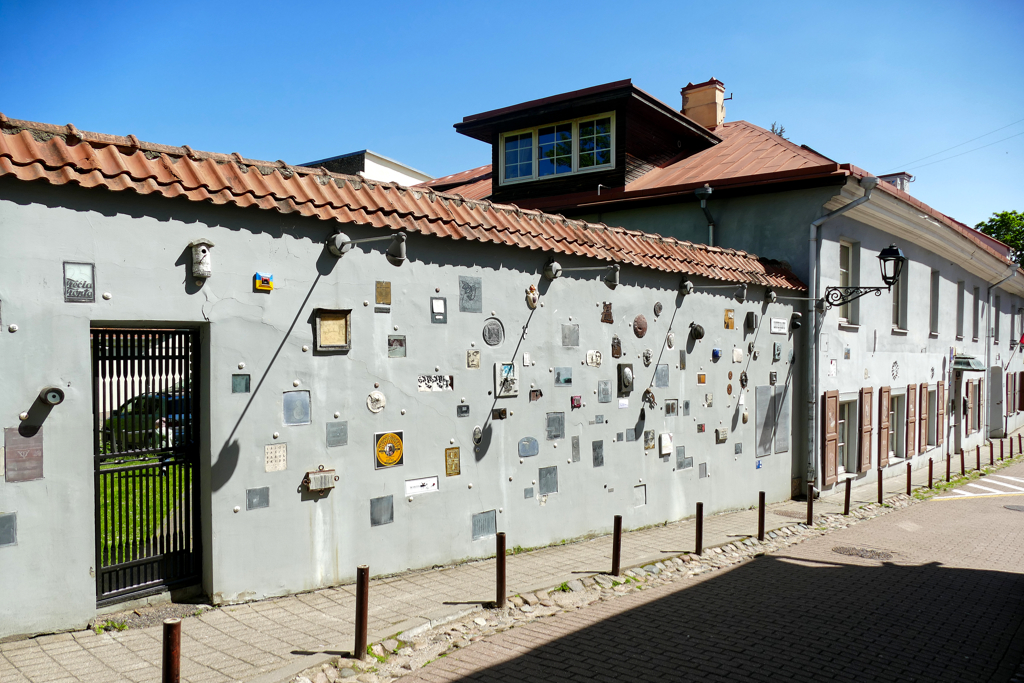
The idea for the design of Literatų Gatvė originated in 2010, on the occasion of the 1,000th anniversary of the first mention of Lithuania. Artists and literature enthusiasts began transforming the small, unassuming street into an open-air gallery. To this end, the walls were decorated with small art panels, ceramic plates, and mini-installations.
Each piece is dedicated to a writer connected to Lithuania by birth, work, or inspiration. Thus, the lane honors Lithuanian authors as well as international literary figures who have written about or worked in Lithuania. The small works of art are symbolically designed, incorporating themes or motifs from the respective authors’ works.
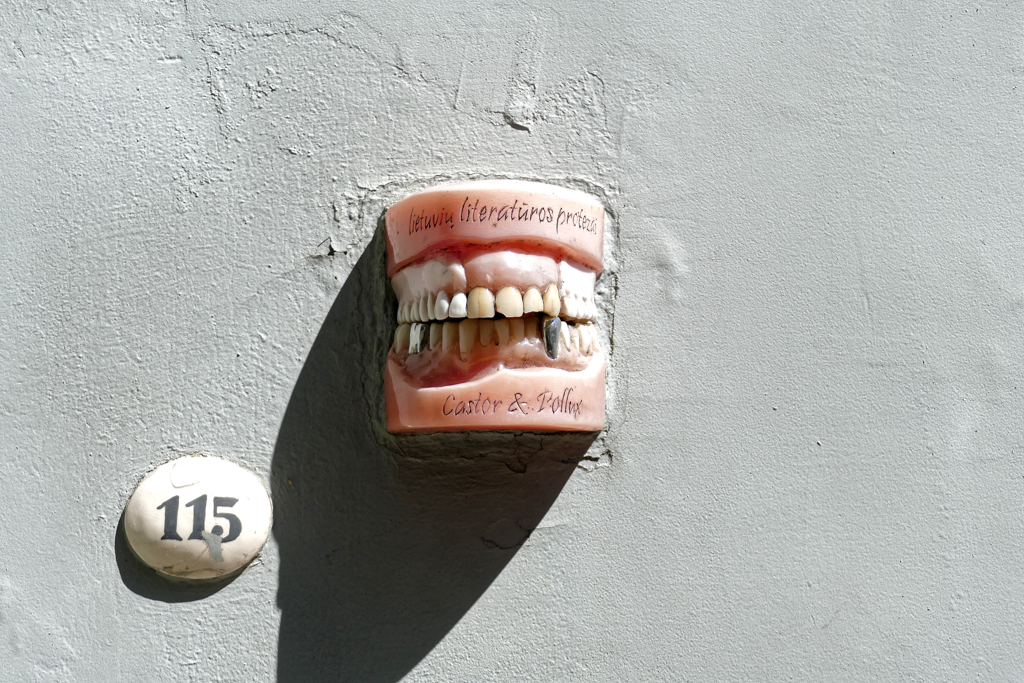
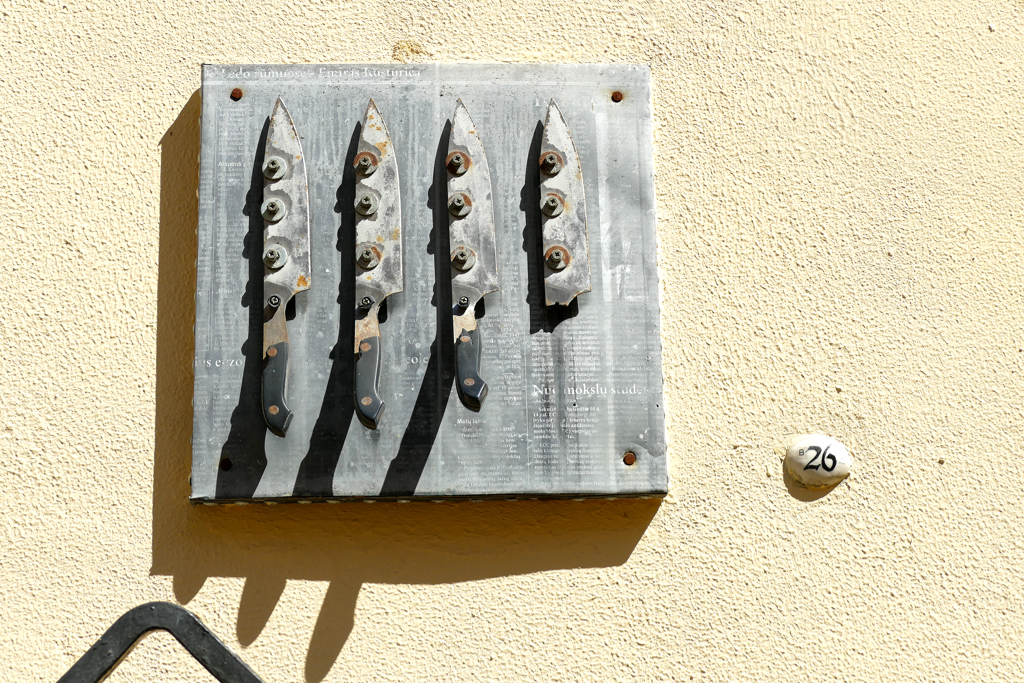
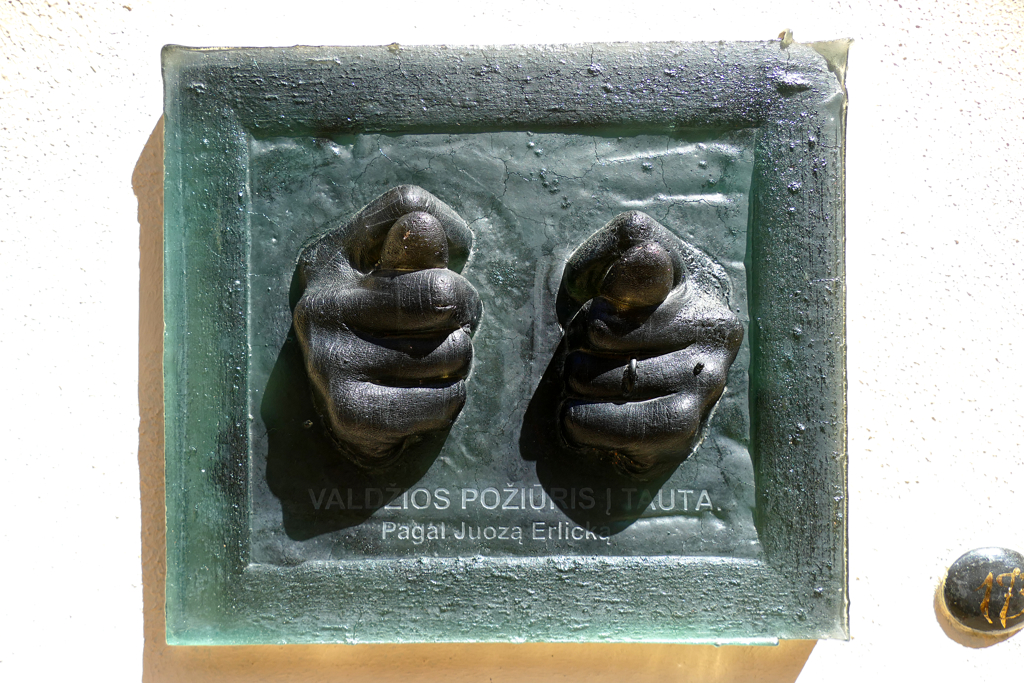
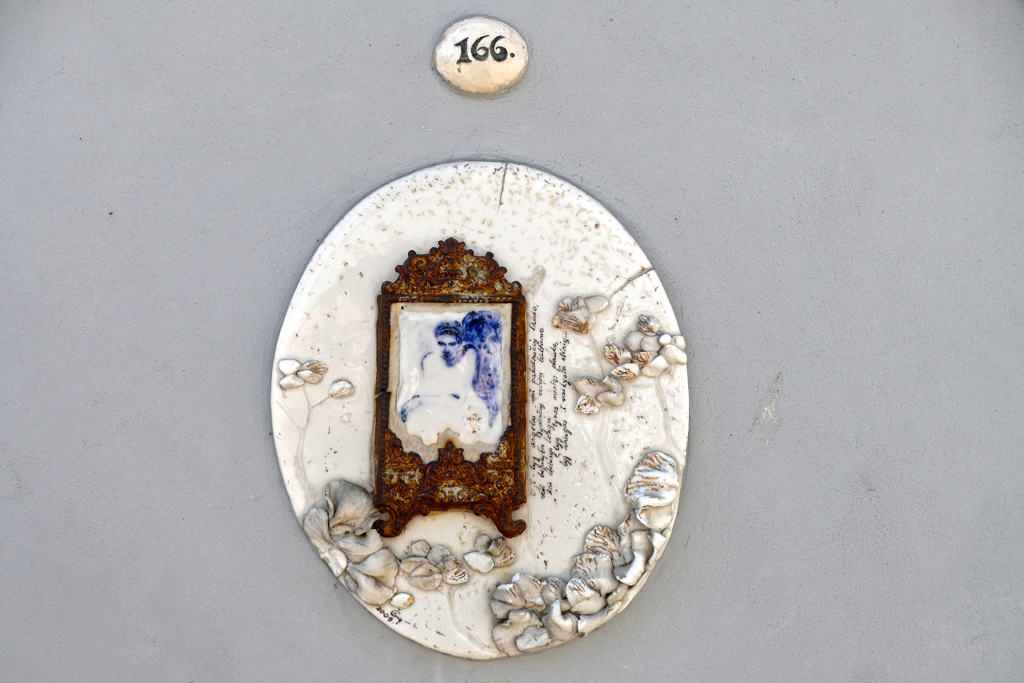
To date, there are over 200 plaques, and the project continues to grow. Literatų Gatvė is a fantastic, living monument that makes cultural memory visible. Despite its short length of only about 100 meters, it is one of Vilnius’s most visited sights. It is a quiet, poetic place amid the bustling old town, demonstrating that great ideas can also flourish in small places.
St. John’s Church And St. John’s Bell Tower
Let me return to the historic complex of Vilnius University, which I briefly mentioned above. It is one of the oldest in Eastern Europe and includes St. John’s Church with its famous St. John’s Bell Tower.
The church was built between 1387 and 1426, shortly after Lithuania adopted Christianity. It is dedicated to Saints John the Baptist and John the Evangelist. Two Johns with one stone, so to speak.
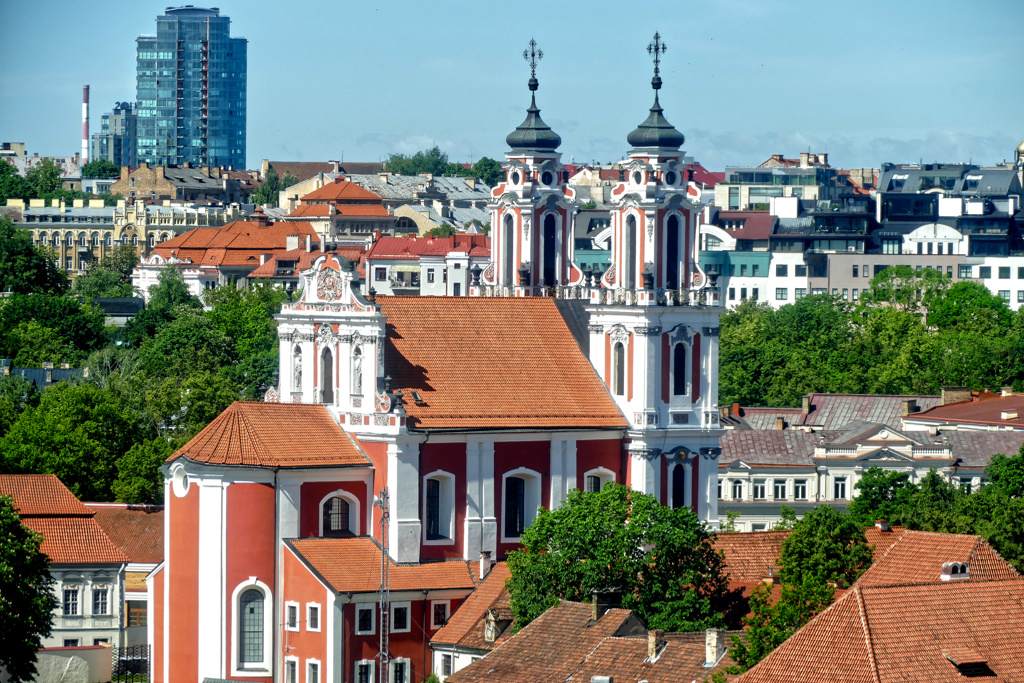
Over the centuries, the church has been rebuilt and expanded several times, particularly in the 16th and 18th centuries, so that today it combines elements of Gothic, Baroque, and Neoclassical architecture. Especially in the Baroque period, it was strongly influenced by the Jesuits, who founded the university in the 16th century and used the church as a university church.
At 68 meters, the Bell Tower is one of the tallest historic towers in Vilnius and has an observation deck offering a 360° view of the old town. For a 5 €uro entrance fee, you can take an elevator up if you don’t want to make the entire climb on foot. From this glass-enclosed level, you already have a good view. However, you can still climb some very steep stairs up to the terrace.
Admission to the St. John’s Bell Tower is also included in the Vilnius Pass*.
The Glass Quarter
Continuing south up Pilius Gatvė, you’ll reach the Town Hall Square, from which the legendary Glass Quarter branches off to the right. This historic district was once the center of Jewish crafts and trade.
The name, of course, dates back to the 17th century, when Jewish glassblowers, mirror makers, and jewelry dealers settled here. The narrow alleyways, small courtyards, and workshops characterized the district.
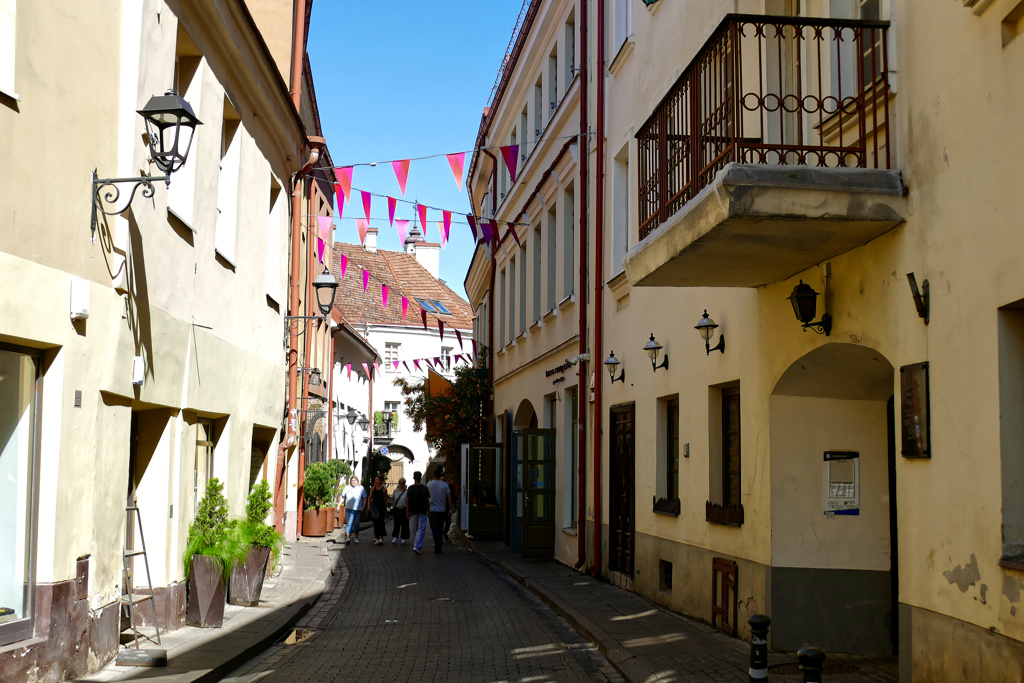
The district was an integral part of the Great Vilnius Ghetto, established during the German occupation in World War II. Many of the Jewish families living here fell victim to the Holocaust.
After the war, the district fell into decline for decades. Only in the last 20 years has the potential of this unique urban space been rediscovered. Between cobblestones and the creative scene, the Glass Quarter is now a hub for art, design, cuisine, and Lithuania’s Jewish history. Much has been thoroughly restored, and the district has developed into one of the most characteristic parts of the old town.
Jewish Life in Vilnius
For centuries, Vilnius was also known as the so-called Jerusalem of the North, as it was one of the most important centers of Jewish life in Eastern Europe.
The Jewish community was tolerated from the 14th century onwards and grew rapidly. Especially in the 17th and 18th centuries, the city developed into an intellectual center of Judaism. In the 19th and early 20th centuries, secular Jewish culture also flourished, characterized by newspapers, theater, political movements, and educational institutions.
With around 60,000 people, Jews made up about a third of the city’s population before World War II. With the occupation by Nazi Germany in 1941, the Great Vilnius Ghetto was established. Within a few years, the Jewish community was almost completely wiped out. What irritated me during my visit was the complete silence about local collaboration. As is well known, during the German occupation of Lithuania, anti-Jewish violence occurred on a shocking scale, some of it carried out by Lithuanian nationalists, militias, and even civilians. In many cases, Lithuanian auxiliary police and paramilitary units carried out so-called purges as well independently as under Nazi command.
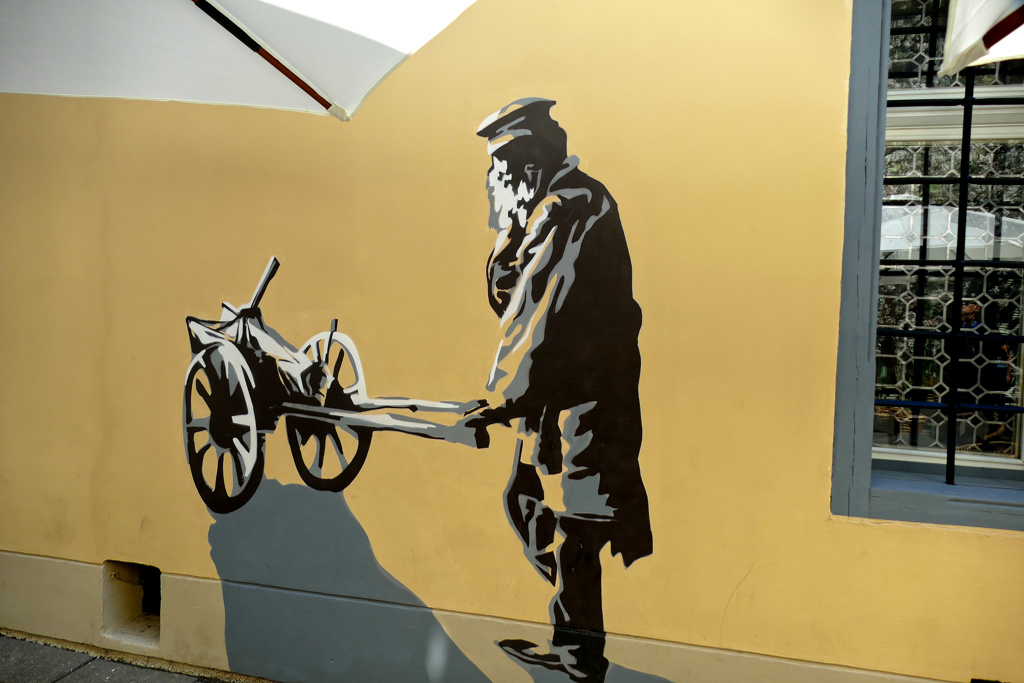
During the Soviet era, said collaboration remained largely taboo. Only since Lithuania’s independence has a more critical examination begun. Yet, the involvement of Lithuanian collaborators in the Shoah remains an ugly stain on the country’s history. Nevertheless, today, Vilnius purposefully commemorates its Jewish heritage, for example, in the Glass Quarter. However, Lithuanian involvement in its past elimination remained unmentioned during guided tours.
The Southern Part of the Old Town
I can’t remember ever seeing a higher density of churches anywhere than at the southern end of the historic old town. Within just a few square meters, you’ll find five magnificent sacral buildings before you leave the old city center through the Gates of Dawn. Whereby, the gates are also a place of pilgrimage and deep worship. I’m telling you, it’s incredible. If you take your time, you can spend almost an entire morning strolling from one beautiful, historically significant church to the next on this tiny stretch. If you need a total of let’s say a hundred steps, you’ve already taken a detour.

Coming from the old town, the first church on your right is the Holy Trinity Uniate Church. You enter the grounds through the magnificent Basilian Gate.
The Holy Trinity Uniate Church in Vilnius is one of the oldest churches in the city. It was founded in the 14th century but acquired its current form in the 16th century. Originally built as an Orthodox church, it was transferred to the Greek Catholic Church in 1609 after the Union of Brest. The Basilians, an Eastern Orthodox monastic order, oversaw the adjacent monastery. The architecture of the complex is a blend of Gothic, Renaissance, and Baroque styles, reflecting its historical transformation.
The church is also famous for its connection to the Ukrainian national poet Taras Shevchenko, who was imprisoned here for some time.
Crossover
Directly across the street is the Orthodox Church of the Holy Spirit. Originally founded in the 14th century, it received its current Baroque form in the 18th century. Today, it is the most important spiritual center of Lithuania’s Orthodox believers.
The church is known for its magnificent interior, with richly gilded iconostases and frescoes in the Russian Orthodox style. Particularly significant are the relics of the three Orthodox martyrs of Vilnius, namely Anthony, John, and Eustathius, which are kept here. These martyrs are considered saints and were executed in the 14th century under the pagan Grand Duke Algirdas.
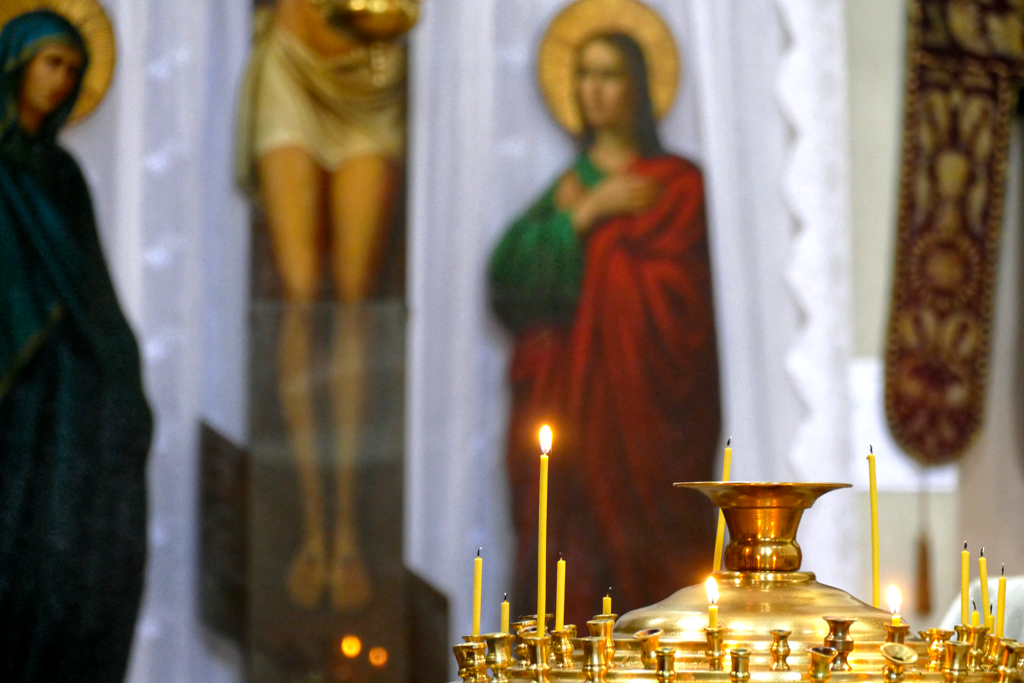
During the Soviet era, the church, unlike many other religious buildings, remained open for worship throughout the year and became a symbol of the Orthodox faith in the region.
Just behind the Orthodox Church of the Holy Spirit is the Orthodox mothership, that is the Lithuanian Orthodox Archdiocese. It is the representative of the Russian Orthodox Church in Lithuania and comprises approximately 50 parishes, monasteries, and social institutions throughout the country.
The origins of Orthodoxy in Lithuania date back to the 13th century. Obviously, in the 19th century, during the hegemony of the Russian Empire, the number of Orthodox believers increased significantly. After World War II and during the Soviet era, however, the church remained active under limited state control. Today, the archdiocese serves primarily Russian-speaking believers, but also some Lithuanian Orthodox.
Back in Time
A stone’s throw away, and you don’t even have to throw the stone very far, is the Church of St. Theresa. Built between 1633 and 1650, it is one of the oldest Baroque religious buildings in Lithuania.
The church is dedicated to St. Theresa of Avila and was built by the Carmelites. Its façade is richly structured and features decorative elements typical of early Italian Baroque. The interior is particularly magnificent, with elaborate altars, frescoes, and stucco decorations.

St. Theresa is located right next to the famous chapel annex containing the image of Our Lady of Mercy, one of the most important pilgrimage sites in the Baltics. Due to its location, it is frequently visited by pilgrims who wish to view the miraculous image through the Chapel at the Gate of Dawn.
The church is not only a religious center, but also an example of the connection between Lithuanian and Polish culture. Today, it serves the Roman Catholic community.
The Gates of Dawn
Yes, and that brings us to the gateway to the historic city center. The Gates of Dawn are one of Lithuania’s most important religious and historical landmarks. They were built in the early 16th century as part of the city’s defenses and are the only remaining city gate of the original ten.

The gates are famous primarily for the chapel housed within them, containing the image of the Blessed Virgin Mary. It was brought to the newly built chapel above the gate by Carmelites in the 17th century. This icon attracts pilgrims from all over Europe, especially from Poland and Lithuania. Many believers attribute miraculous healings and protective powers to it. Hence, the Gates of Dawn are not only a religious site but also a cultural symbol as they play a central role in Lithuanian identity and spirituality.
There’s More
You won’t believe it, but these five churches are just a fraction of what Vilnius has to offer in terms of places of worship. The churches built in the so-called Vilnius Baroque style, in particular, are true architectural marvels. Since it would go beyond the scope of this post to present them all, I’ve compiled the 15 most outstanding ones and presented them in detail in my post Vilnius Baroque: The City’s 15 Most Magnificent Churches.
Pylimo Gatvė
Pylimo Gatvė runs along the old town and forms the western border of Vilnius’s newer districts. The street is known for its eclectic mix of architecture, combining 19th-century buildings with modern remodeling. It reflects Vilnius’s rich history and multicultural heritage. Along the street, you’ll find residential buildings, shops, cafes, bars, and cultural institutions.

A popular stop for visitors, too, is Halės Turgus, the oldest market in Vilnius, dating back to 1906. It’s a lively spot where locals shop for fresh produce, meats, cheeses, baked goods, and more. It is housed in a historic building designed by architect Vladislav Stipulkovski and exudes old-world charm. It’s a great place to take a break at one of the small cafes and street food stalls and to experience authentic local life and taste traditional Lithuanian flavors.
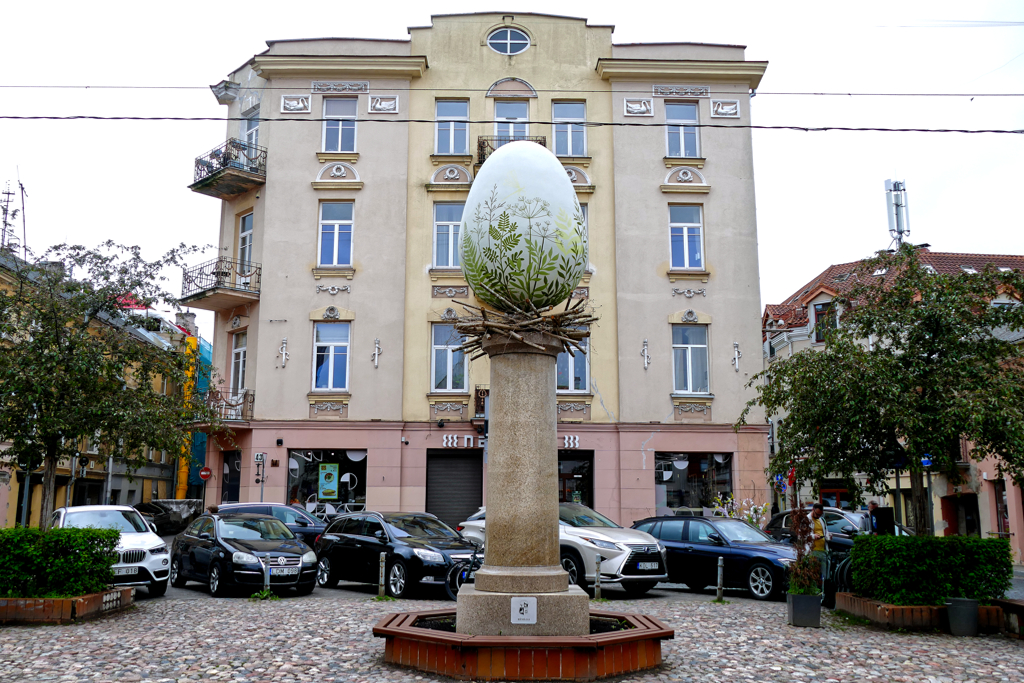
Created by sculptor Romas Vilčiauskas from gypsum in 2001, it is perched atop a granite column. Originally, the egg stood in Užupis Square as a symbolic placeholder for the upcoming Angel of Užupis statue. In 2007, artist Lijana Turskytė painted it with botanical motifs in soft green hues, reflecting Vilnius’s 2025 title as European Green Capital.
As you continue north up Pylimo Gatvė, you’ll sense its slightly edgy, urban character. This part of the city is much less touristy and more popular with students and even artists. While this neighborhood is slowly becoming trendy, it has so far managed to retain its authentic, raw charm and is a great place to experience real Vilnius life beyond the tourist attractions.
And yet, there’s one attraction here that you shouldn’t just pass by.
MO Museum
The MO Museum in Vilnius is a modern art museum, opened in 2018, dedicated entirely to Lithuanian art of the 20th and 21st centuries. Its central location on Pylimo Gatvė links the historic old town and the modern part of the city. The collection includes over 5,000 works by Lithuanian artists, many of which date back to the Soviet era and were ignored by state museums at that time. Today, however, they are a significant part of the national cultural heritage.
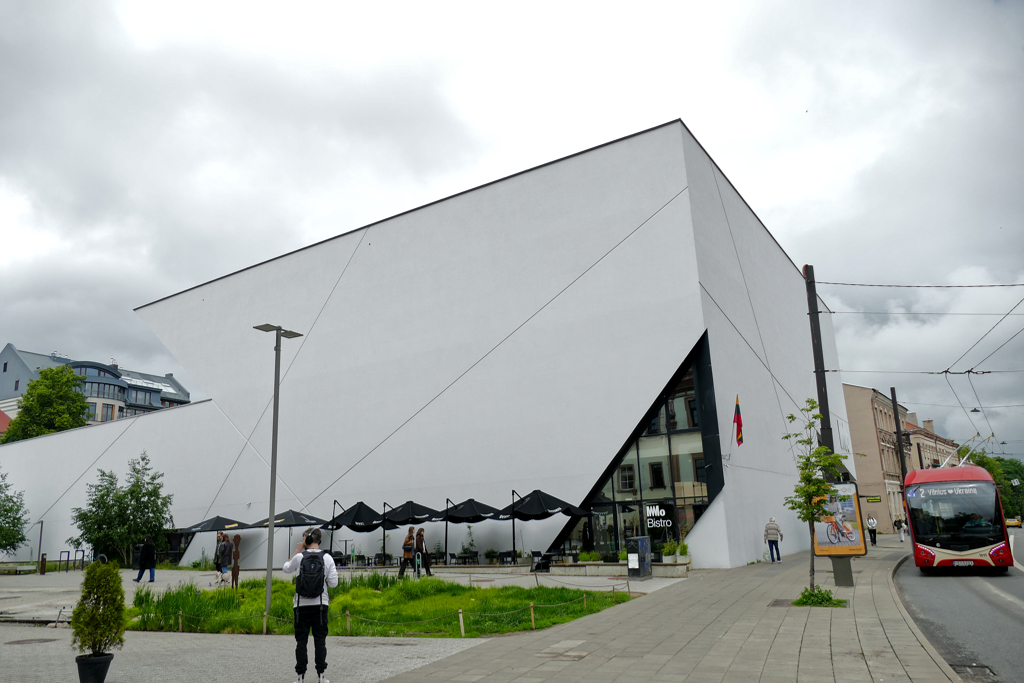
The museum building was designed by the renowned architect Daniel Libeskind. It features striking, modern architecture: a diagonal staircase runs through the building, creating open connections between the exhibition spaces, the café, the museum shop, and the publicly accessible roof terrace with views over the city. Despite its relatively compact size, the MO Museum feels like an urban cultural center.

In the background, Ksenija Jaroševaite’s granite sculpture, appropriately titled Sedinti, hence, Sitting.
In addition to changing exhibitions, the museum also offers a diverse cultural program, including film screenings, concerts, and workshops. It strives to be not only an exhibition space but also a meeting place that promotes art, education, and encourages discourse’n’dialogue.
The MO Museum is open from Wednesday to Sunday between 10 a.m. and 8 p.m. The general entrance fee is 11 €uros, but you’ll get a small discount with your Vilnius Pass*.
Naujamiestis
Naujamiestis, hence, the New Town, is actually one of Vilnius’ most intriguing and evolving neighborhoods, a bit remote from the touristy areas. It is nestled just beyond the limits of the historic old town and wraps around the heart of the capital, blending residential serenity with dynamic urban energy.
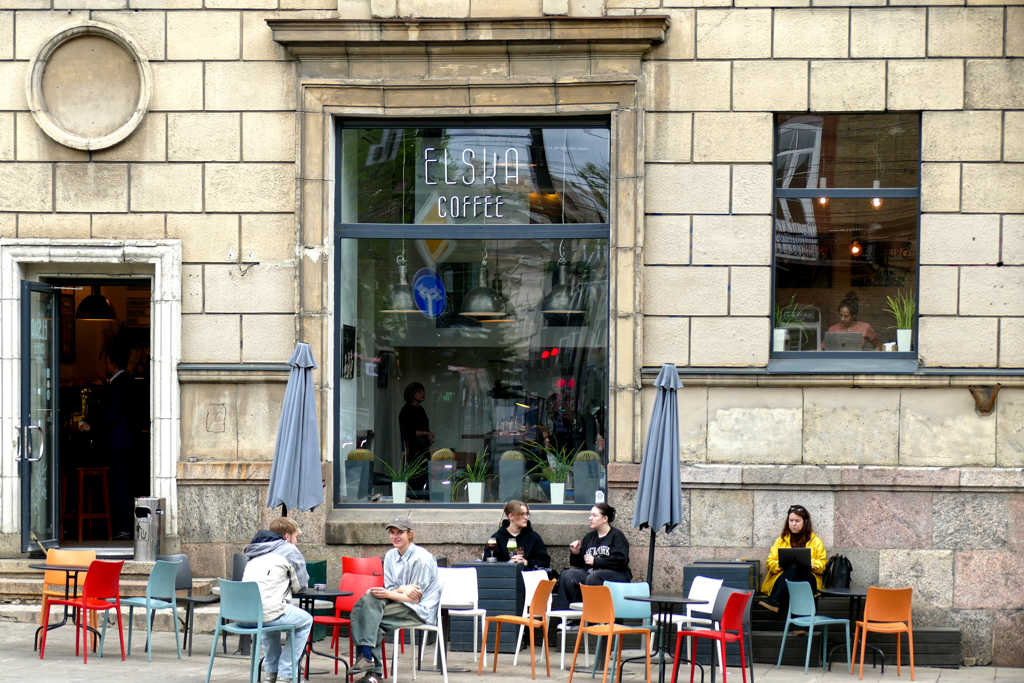
Although the name might suggest that this part consists of soulless, prefabricated high-rise buildings in a brutalist architectural style, Naujamiestis is in fact the result of a century of historical change. Brick houses from the late 19th century stand next to functional Soviet-era apartment blocks, and the neighborhood’s industrial past is hard to miss. Changing with the times, the former manufacturing plants and warehouses now house lofts, galleries, and cafes.

Creative energy pulses through places like the Atvira Meno Galerija, a cultural center in a converted factory where concerts, art installations, and fashion shows bring people together. Also, small businesses such as vintage boutiques, coffee roasters, and co-working studios thrive in this part of the city.
In Motion
Despite its proximity to the historic city center, Naujamiestis feels refreshingly grounded. It’s a place in flux, constantly renewing itself without losing its soul. Gentrification is visible but not overwhelming, and the mix of old and new gives the neighborhood an edgy yet authentic charm.
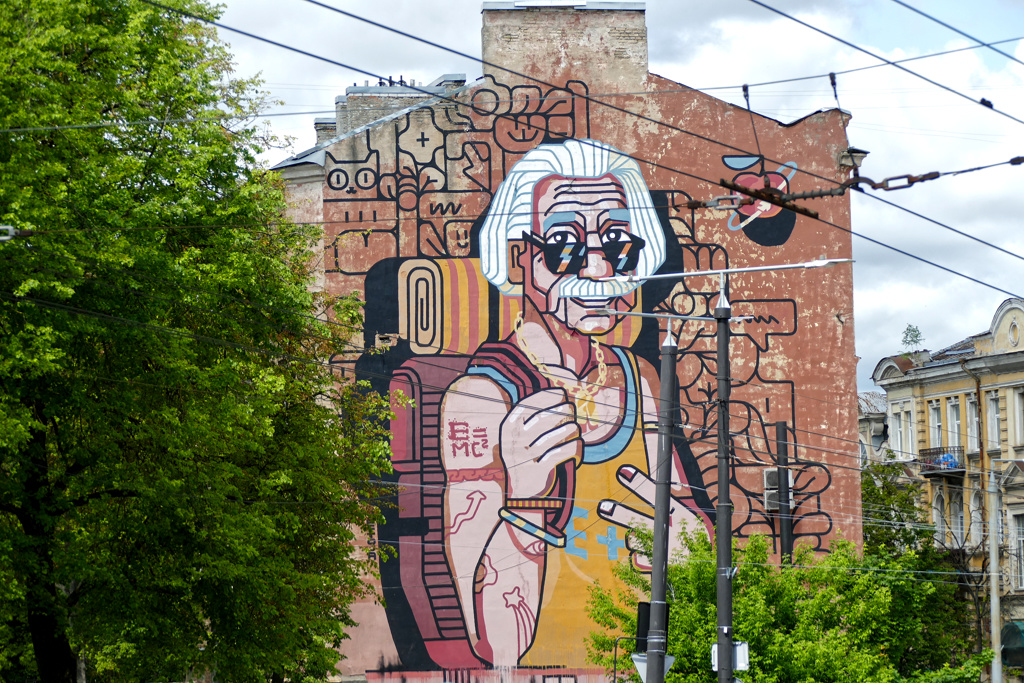
Those who want to experience Vilnius beyond its medieval core or Užupis, which is in danger of becoming a tragically trendy tourist attraction, will find a deeper, more vibrant side of the city in Naujamiestis. You’ll spot residents strolling with their dogs, artists carrying canvases, and young families enjoying the parks and bakeries tucked between courtyards.
Atvira Meno Galerija – Open Air Gallery
One of Naujamiestis’ most amazing features, and actually one of the top highlights of my trip to Vilnius, is the Atvira Meno Galerija. Located about two kilometers west of the city center and just a couple of minutes from the train station, it is one of the city’s most alluring art venues.
The Atvira Meno Galerija emerged as a vibrant cultural project, transforming a former industrial space into a thriving hub for contemporary art. Its origins are deeply tied to the history of the site, which was once home to the Elfa factory, a major manufacturing plant in the city during the Soviet era.
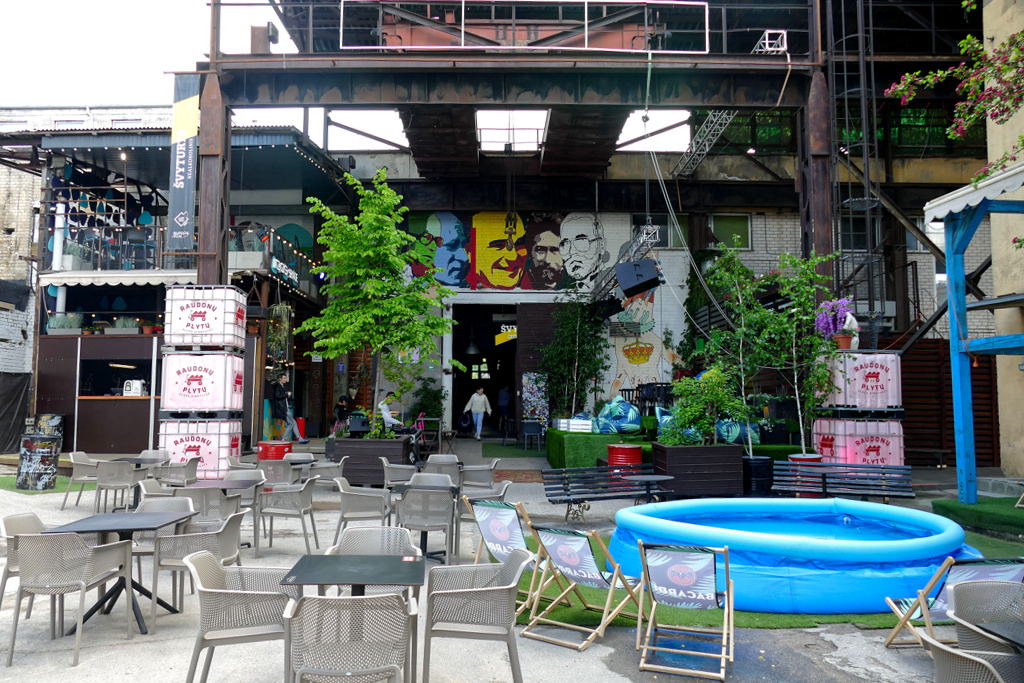
The Elfa factory was established in the mid-20th century and specialized in producing electronic devices and radio equipment. It was one of the key industrial facilities in Vilnius, employing a significant portion of the local workforce. The factory’s large, utilitarian buildings and spacious outdoor areas reflected the industrial architectural style of that period.
However, following the collapse of the Soviet Union and Lithuania’s independence in the early 1990s, many factories, including Elfa, faced decline and eventual closure. The industrial site was left abandoned for years.
Risen From the Ashes
In the early 2010s, however, a group of artists, cultural activists, and community organizers saw an opportunity to reclaim and repurpose the neglected Elfa factory grounds. They envisioned an open-air art gallery that would not only preserve the industrial heritage of the site but also create a dynamic space for creative expression.
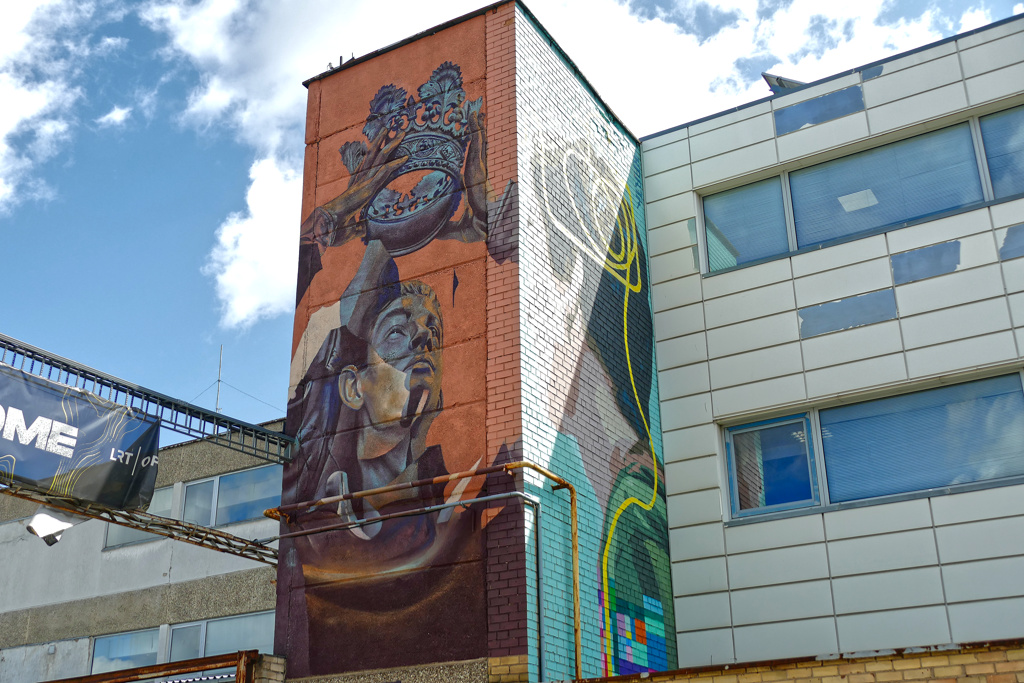
Since its establishment, the Atvira Meno Galerija has grown into an innovative cultural landmark. The large factory walls and outdoor areas became canvases for murals, light installations, sculptures, and other contemporary artworks by both Lithuanian and international artists.
It would go beyond the scope of this post to introduce the project and the works in detail. Therefore, I’ve dedicated a separate post to urban art in Vilnius, including the best pieces at Atvira Meno Galerija: Best Street Art in VILNIUS.
Žvėrynas
Vilnius has one of the largest historic old towns in Europe, so it’s not surprising that most visitors don’t have time to explore other must-see parts of the city. However, you should do so if possible. From Cathedral Square, bus #11 departs in the direction of Užupis and takes you to Žvėrynas in less than half an hour. Don’t be confused by the fact that Užupis is listed as the final destination. The bus actually passes through Užupis and then continues through Naujamiestis to Žvėrynas. The fact that it passes many other interesting spots in the Naujamiestis neighborhood is a nice plus.

Žvėrynas is one of the most picturesque and characteristic districts of Vilnius, known for its wooden architecture, its almost village-like atmosphere, and its green surroundings. The name literally means animal garden, a direct reference to the district’s origins in the 16th century. At that time, the area served the Grand Duke of Lithuania as a hunting ground. Later, in the 19th century, it became the property of a wealthy Russian nobleman, who established a private zoo with a game reserve and summer residence there.
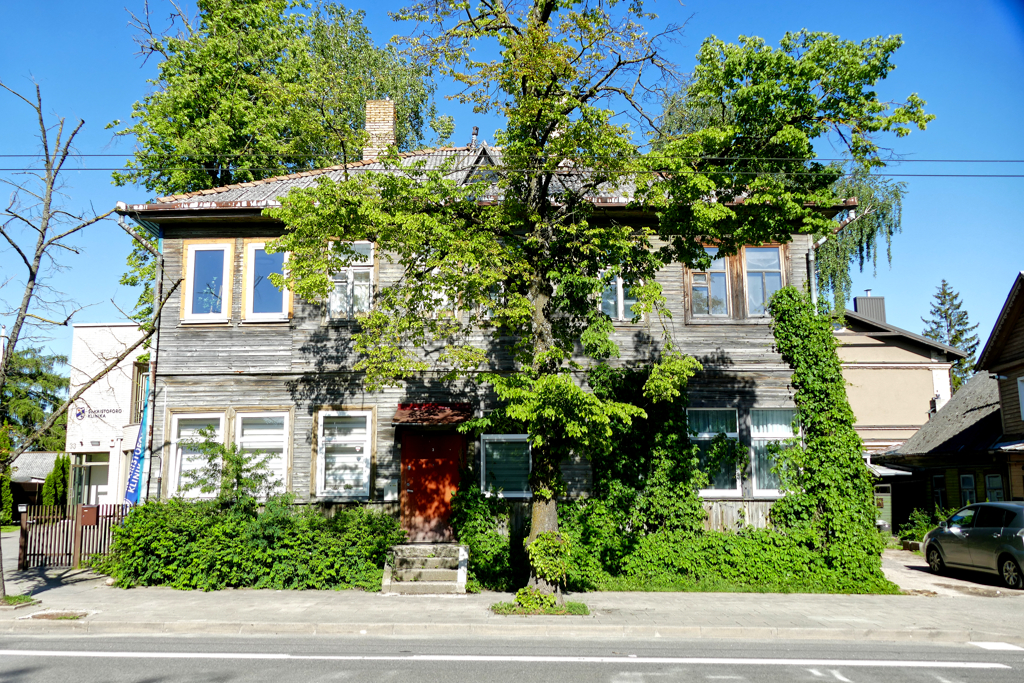
When around 1900, Žvėrynas was incorporated into the city of Vilnius, it developed into a middle-class residential neighborhood with charming wooden houses in Art Nouveau and Eclectic styles.

Today, Žvėrynas uniquely combines historical charm with a contemporary lifestyle. When strolling through its quiet streets, you’ll discover a part of Vilnius that’s rich in history, architectural treasures, and urban life close to nature. These features make Žvėrynas a sought-after place to live as well as a popular recreational area.
Užupis
An extremely different kind of neighborhood from Žvėrynas is Užupis. So far, it is certainly one of the most interesting neighborhoods in Vilnius.
But why so far?
Well, I’ll explain myself after I introduce you to this creative, playful, and somewhat rebellious part of the city.
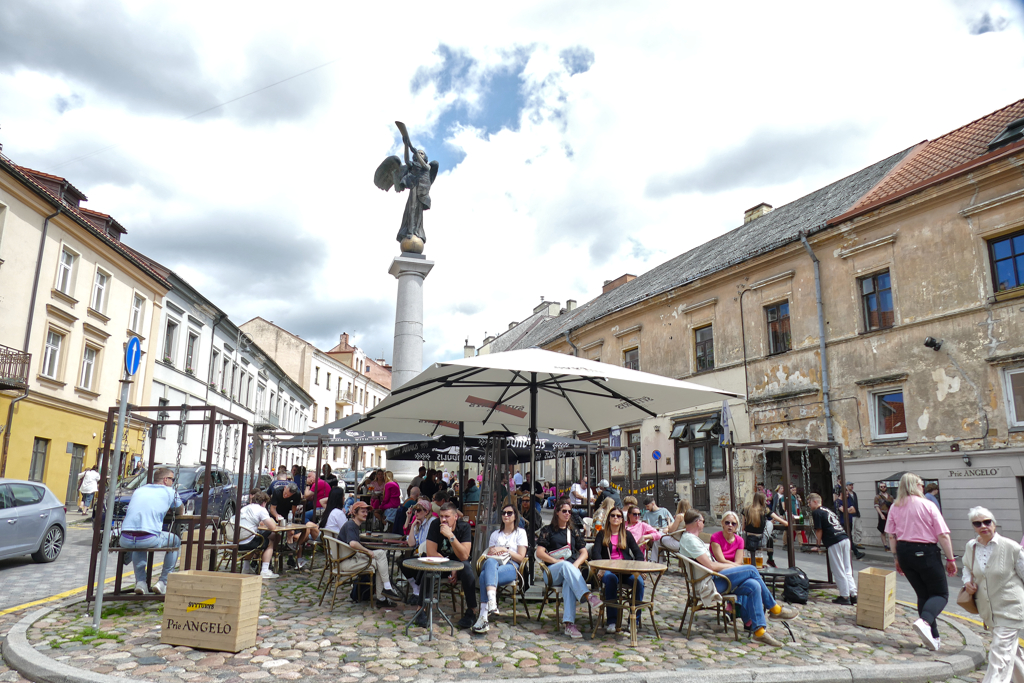
The name Užupis means beyond the river and aptly describes its location: The district is separated by the small Vilnia River directly east of the old town.
This location made Užupis a simple suburban neighborhood for centuries, inhabited by workers, artisans, and later also Jewish families. It was located on the outskirts of the city, was often flooded, and suffered long-term infrastructure neglect. After World War II, the neighborhood rapidly deteriorated, particularly during the Soviet era. Many buildings stood empty, and it was considered a social hotspot.
Tables Turn
After Lithuania’s independence in 1990, artists, creatives, and nonconformists discovered the neighborhood. They began occupying empty houses, setting up studios, and transforming the area into an alternative cultural space.
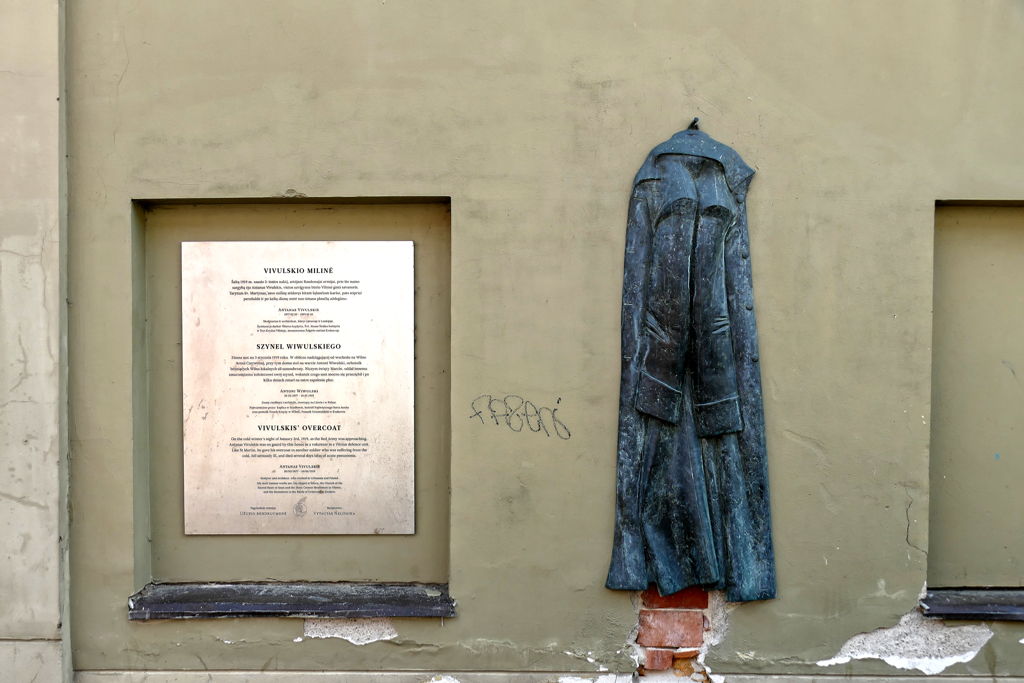
This culminated in the residents symbolically proclaiming the so-called Republic of Užupis on April 1, 1997. This was an ironic and poetic statement for self-determination, artistic freedom, and humanity. Since then, Užupis has had a small border post, a flag, and a president. The constitution of the free republic can be found along Paupio Gatvė. It is displayed on metal plaques in over 50 languages.
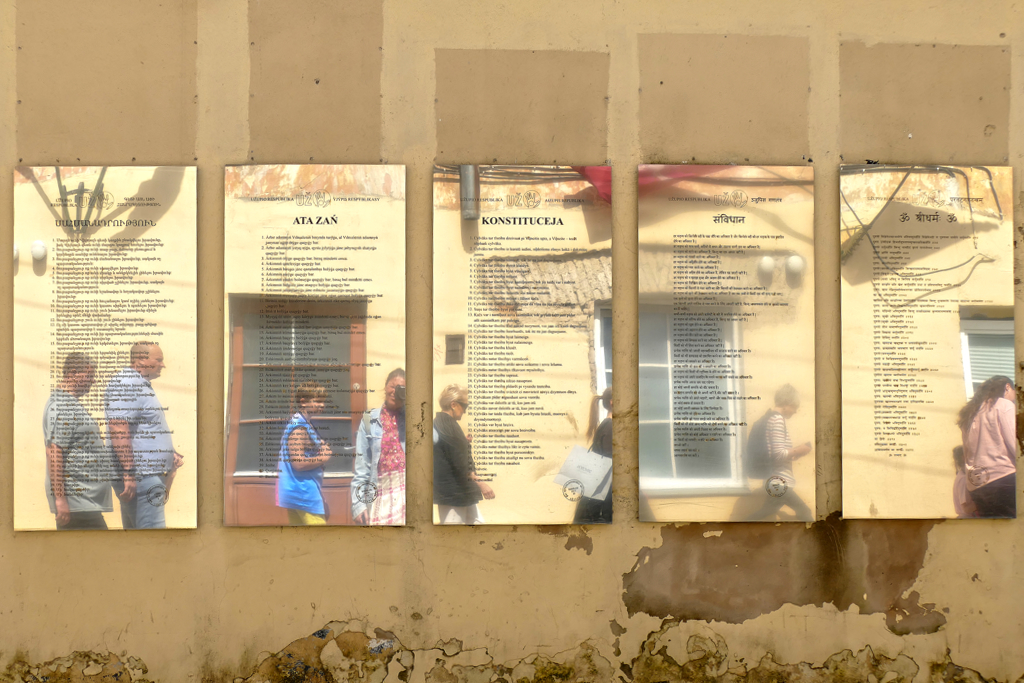
Despite increasing popularity and gentrification, Užupis remains a symbol of freedom, creativity, and cosmopolitanism.
Nevertheless, I had the strong feeling that Užupis was right at the top of the to-do list of every tourist, right after the Gediminas Tower and the Palace of the Grand Dukes. It reminded me a bit of Camden Town in London or Christiania in Copenhagen, where what started as an anarchistic and subversive space for subcultures slowly degenerates into a kind of trendy theme park. To be honest, I’m a little worried about Užupis.
Honoring the Past
Regarding Lithuania’s past, there are two museums I didn’t visit, even though I consider the subject matter essential to understanding today’s Lithuania. The reason I skipped at least the first one listed below is that I’m already quite familiar with the history of what was once the so-called Eastern Bloc from my own past: I was born in the former Czechoslovakia, and my parents fled the Warsaw Pact troops to Germany, which was still divided into two very different countries at that time.
So, in this case, I actually lived history.
Also, I visited museums and memorials dealing with that dark era in cities like Berlin, Budapest, and Prague. Therefore, due to the limited time I had in Vilnius, I skipped a visit in favor of other landmarks.
Museum of Occupations and Freedom Fights
The Museum of Occupations and Freedom Fights, better known as the KGB Museum, is located in the former headquarters of the Soviet secret service. The building was originally built in 1899 and initially served as a court. During the Soviet occupation from 1940 onwards, the KGB used the building for interrogations, torture, and executions of political opponents. The basement contained a prison with cells, solitary confinement areas, and an execution chamber. Between 1944 and the early 1960s, over 1,000 people were executed there, many of them Lithuanian resistance fighters.
The museum is open Wednesday to Saturday from 10 a.m. to 6 p.m. It closes already at 5 p.m. on Sundays. The entrance fee is €6, but it is included in the Vilnius Pass*.
Lukiškės Prison 2.0
I have very mixed feelings about the second historical site, Lukiškės Prison. It used to be one of the most important prisons in Lithuania and was notorious for its political and historical role during several regimes. I find it strange that a place where so many people suffered and even lost their lives is now synonymous with fun and follies. Somehow, I think there should be a minimum of empathy and good taste even when it comes to dark tourism.
This being said, the prison was completed in 1905 under the rule of the Russian Empire. Although it was designed for around 300 prisoners, up to 1,000 people were held there.
During the Tsarist era, political prisoners, revolutionaries, and criminals were imprisoned here. The Nazis also used it as a detention center and transit point for Jewish prisoners and resistance fighters. After World War II, it continued to operate as a Soviet and later Lithuanian state prison.
Since 2020, the so-called Lukiškės Prison 2.0 has been a cultural center hosting concerts, art projects, exhibitions, and guided tours. It also gained international fame as a filming location in the fourth season of the series Stranger Things.
The former prison is open for guided tours. Since times vary, please check the official website when planning your trip. Daytime tours cost between 15 and 20 €uros, and night tours cost around 20 €uros. You can get a discount with the Vilnius Pass*.
Practical Information
How To Get There
Air Travel
Vilnius Airport is the largest and busiest airport in Lithuania and is located about 6 kilometers south of the city. Getting from the airport to the city center is super easy, even by public transport.
There is a small train station directly in front of the airport. The train ride to Vilnius Station takes about ten minutes and a ticket costs about 1 €uro. Alternatively, bus line #88 connects the airport to the city center and the major hotels for as little as 90 cents.
Between midnight and 5 a.m., night bus #88N shuttles passengers for the same fare.
As I landed at 1 a.m., I didn’t bother with public transport but just hopped into a cab right outside the terminal. The ride to the center of the historic old town set me back 21 €uros. An amount well spent. However, Bolt and Uber are also widely available in Lithuania and offer cheaper fares.
You can also find various car rental companies at the airport. However, I would argue that due to Lithuania’s excellent transport network, you don’t need your own car even to explore the outskirts of Vilnius.
Land Travel
Vilnius has a rather modest yet reliable rail network. Connections are primarily to neighboring countries such as Latvia and Poland. Connections to Belarus and Russia are currently suspended, obviously.
The high-speed railway project Rail Baltica is under construction and expected to be in operation by 2030. It will then connect Vilnius with Tallinn, Riga, Warsaw, and parts of Western Europe in the blink of an eye.
Since train connections are limited, many travelers opt for long-distance buses. Various companies offer regular and very affordable connections to Latvia, Estonia, Poland, and Germany. The modern bus terminal is located right next to the train station. As there are many connections at really reasonable fares, it’s all the more sad that the often extremely arrogant and downright rude bus drivers spoil what could be a pleasant experience. I’ve already addressed the fact that bus drivers tend to be a unique breed of people in my post Travelling by Bus Around the World or Ride with the Devil.
How to Get Around
The old town is easy to explore on foot. Since some of the main sights are located in hilly areas and many streets are cobblestoned, I can’t really recommend exploring the city by bike. Nevertheless, it is an option.
Like virtually all European cities, Vilnius has a well-developed public transportation system, consisting primarily of buses and trolleybuses. The network is comprehensive and, above all, very affordable. Interestingly, it is supplemented by privately operated minibuses, which are integrated into the official system, but run mainly on the less frequented routes. However, these minibuses are faster than regular buses and have fewer stops.
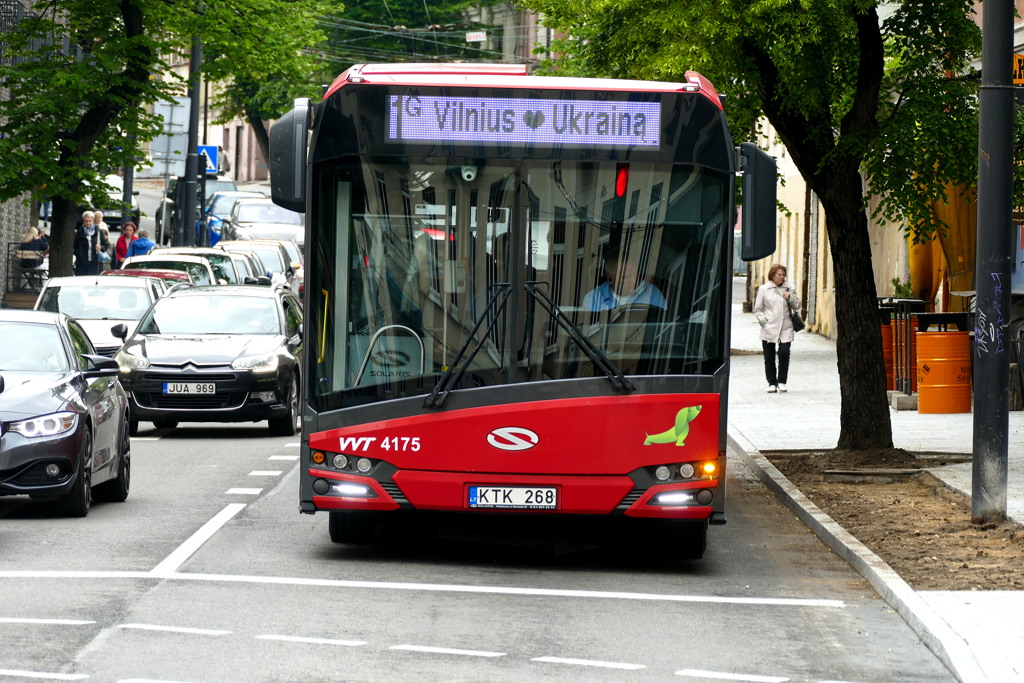
Regular bus service runs from 5:30 a.m. to midnight. After that, night buses run throughout the night with a limited schedule.
A single ticket costs 0.65 €uros in an app, whereas a paper ticket costs 0.90 €uros. For 5 €uros, you can get a 24-hour day ticket, and a 3-day ticket costs only 8 €uros. Note that apparently, the app works only with Lithuanian phone numbers, and everything is in Lithuanian. Therefore, I’d argue that the best way to buy tickets is by getting the Vilniečio Card. There are ticket machines at some stops, and paper tickets are also available on the bus. Keep in mind that you cannot pay cash but need to use a contactless means of payment.
Visiting Organized
I’m an avid solo-travelling woman. Since solo travel doesn’t equal solitude, I love to join organized tours here and there. They allow me to meet fellow travellers – for just a short moment or a lifelong friendship.
Therefore, here are some great ideas of what to do during your stay in Vilnius. Especially if you have only a short amount of time, they’ll enable you to leave the planning and organizing to others and just enjoy the city and the surrounding area to the max**:
Where to Stay
So, after arriving in Vilnius in the middle of the night and seeing the city lit up and unrealistically beautiful for the first time, I was pretty pumped. I didn’t really feel like going to bed. I wanted to enjoy my huge room, make myself a delicious coffee with the coffee machine, snuggle up in the big, soft armchair with my feet on the matching stool, and snack on the little sweets the hotel had provided for me.

On the other hand, I knew that three full days of fun and follies lay ahead of me, so just a quick, relaxing shower in the elegant bathroom and then off to bed.
After a refreshing night in which I slept like a baby, I open my eyes and let my gaze wander around the room, which is now indirectly illuminated by a few rays of sunlight.
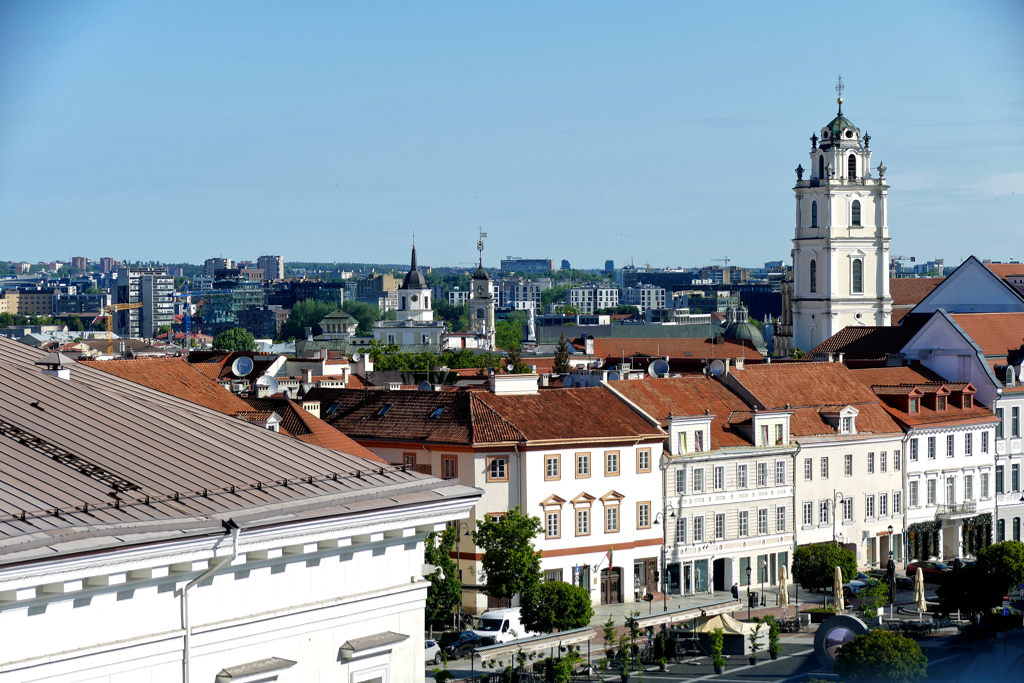
What I had missed last night was a kind of covered terrace clad in elegant gray wood. The roof is made of slats that can be adjusted so that from here, you have a million-dollar view of the Church of St. Casimir opposite, the town hall square, and far beyond. I can’t believe having such an amazing view!
Headstart into Happiness
And the understated splendor continues as I enter the restaurant on the ground floor. With small cast-iron tables and chairs in front of slightly opaque mirrored walls under enormous chandeliers, it has the feel of a French café from the Belle Époque.
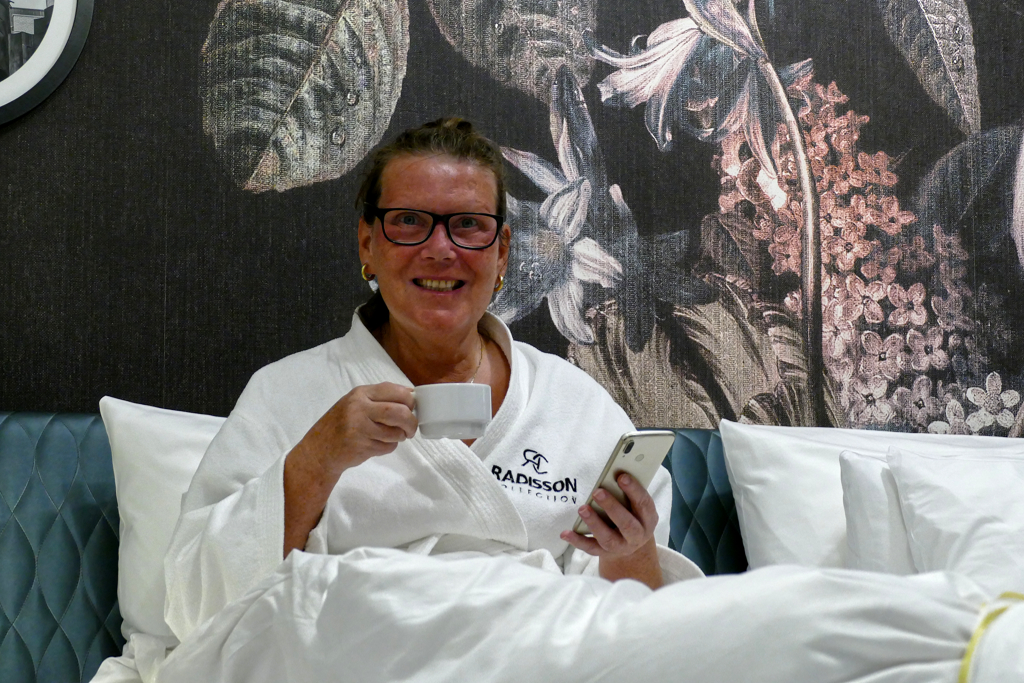
And the fact that it’s interspersed with real trees even gives it the feel of a sidewalk café. I’m here in June, and the weather is beautiful. But I can well imagine that during the long Baltic winter months, this southern atmosphere can help lift spirits.
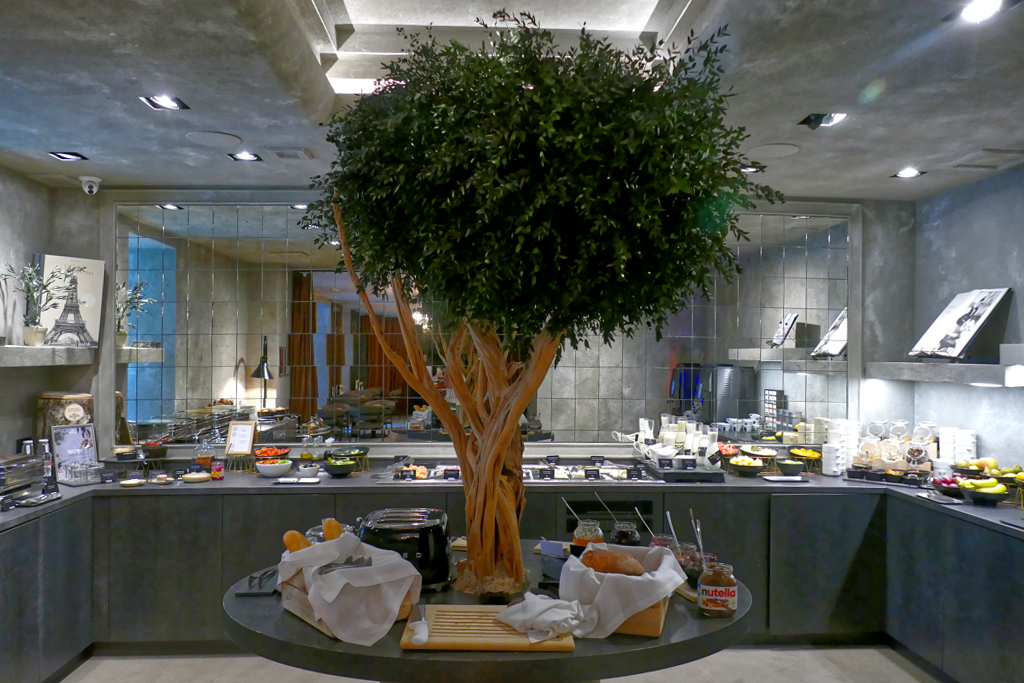
Talking about the Baltic climate: It had become increasingly overcast throughout the day, and then in the afternoon, a downpour hit the city. I returned to the hotel, soaking wet, a little embarrassed to leave a trickle of raindrops running down my raincoat on my way to the elevator.
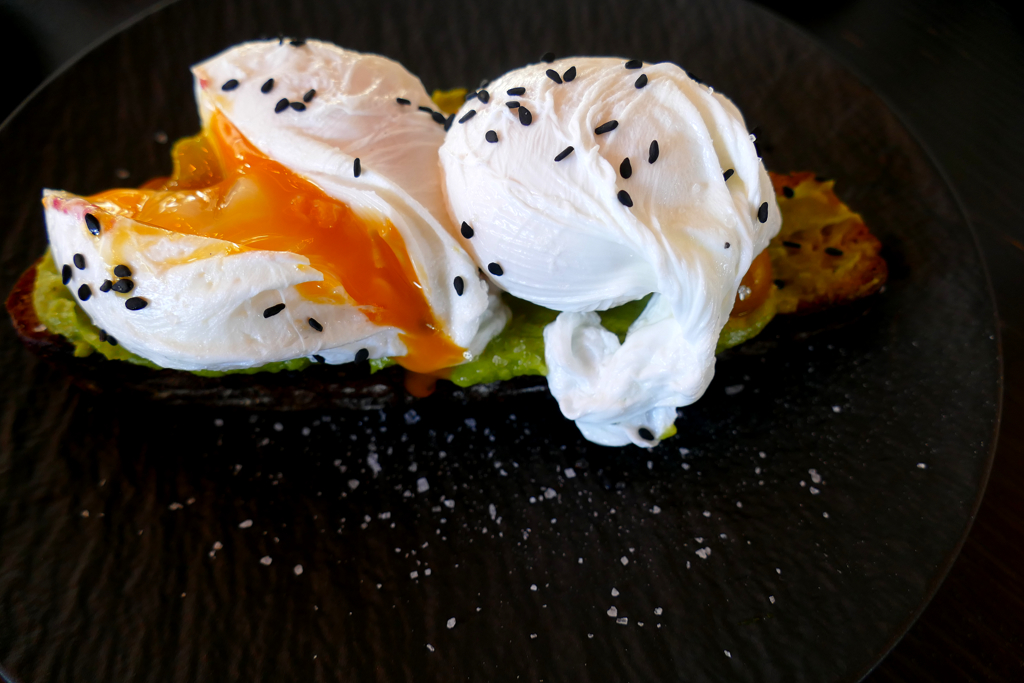
It’s early evening, I’ve already eaten, what should I do now? A walk is definitely not an option. There’s this so-called health center downstairs; I’ll give it a try. So I take my swimsuit, the cozy bathrobe, and the slippers provided and head downstairs. In the changing room, I slip into my swimsuit and swim lap after lap in the pool. Afterwards, I let the water massage me in the Jacuzzi. Sanum Per Aquam – water is just so relaxing! I finish my wellness session with a hot sauna and call it a day.
Let’s Get the Party Started
The next day, I get to know Vilnius in a different way, in brilliant sunshine. The city has the reputation of being able to experience all four seasons in one day. I don’t know about that, but the difference from the first day is impressive.
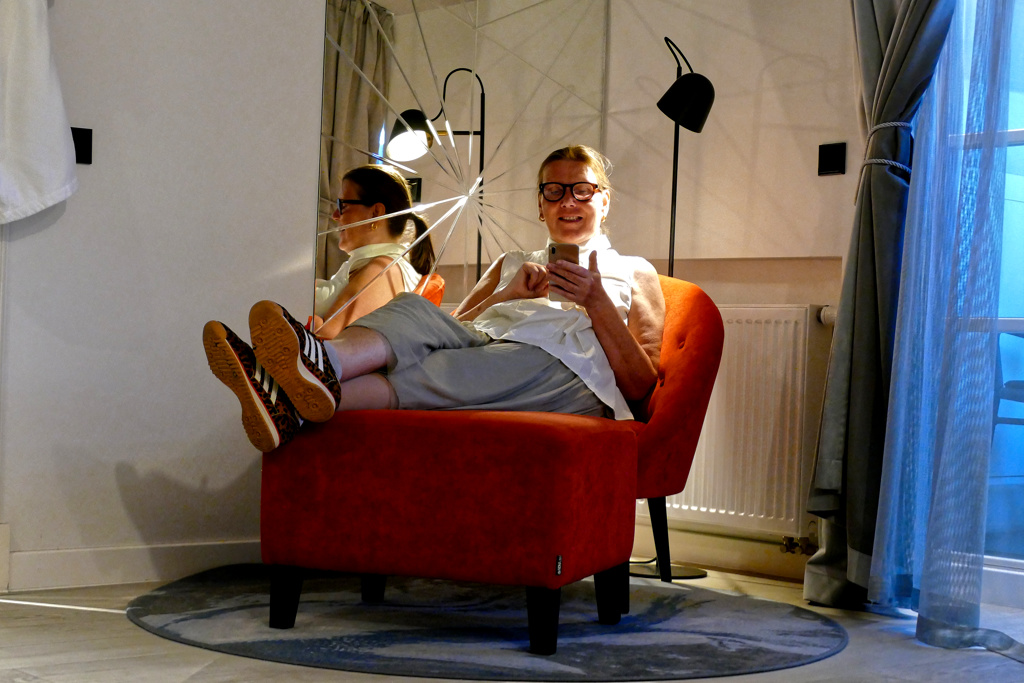
After an early dinner, I consider the golden hour too precious to spend in the basement sauna. As I step out onto my small terrace, I hear quiet laughter and the clinking of glasses not far away. I’d seen pictures of a rooftop bar somewhere. And since I’m staying on the top floor of the hotel, it can’t be far.
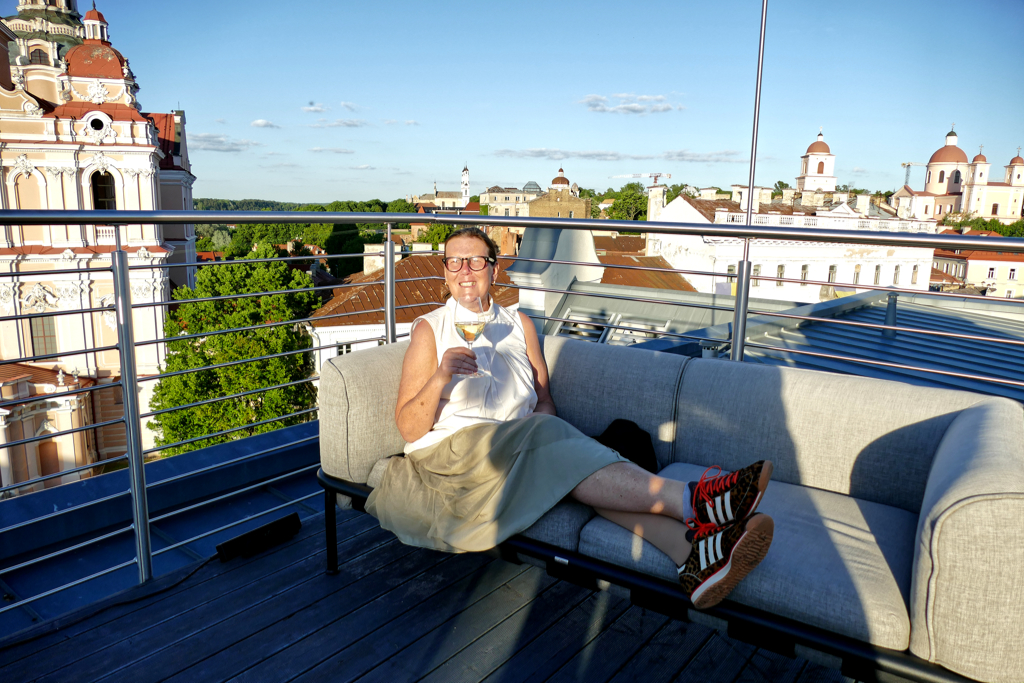
Once down the corridor, through a glass door, and then up a few steps, I’m standing on a small, cozy roof terrace. All of Vilnius is at my feet. Well, if that isn’t the perfect end to the day, I don’t know what is. I order a glass of white wine and sink down onto one of the sofas with a dreamy smile.
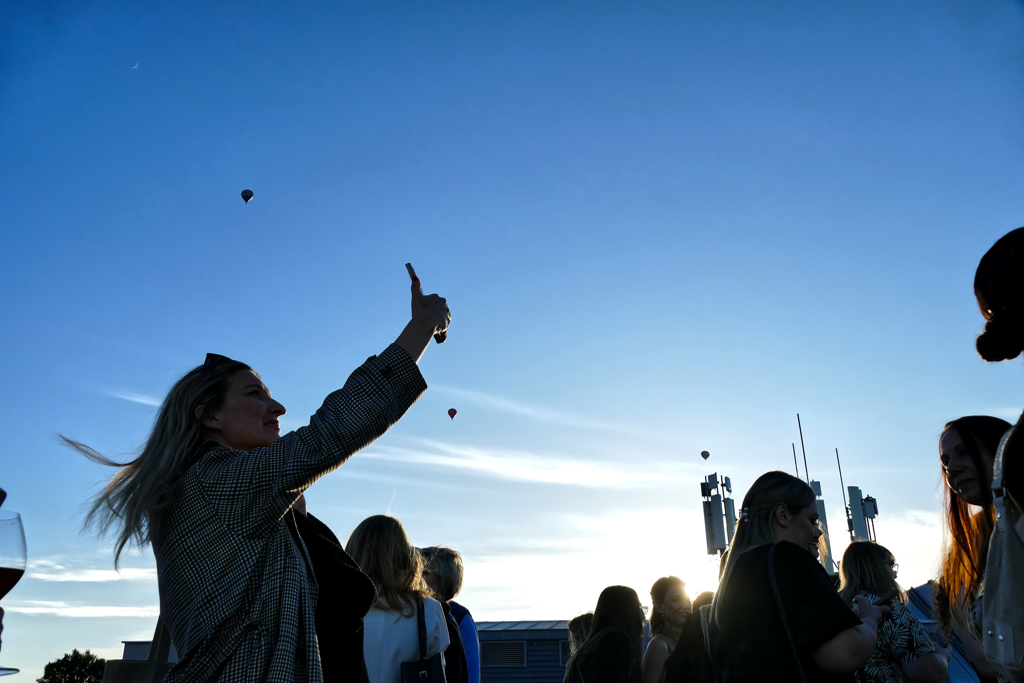
I’ve just taken my first sip when I see them: Like colorful soap bubbles, kaleidoscopic hot air balloons rise one after the other and glide magically through the setting sun over Vilnius.
Now, don’t anyone say there are no miracles!
They’ve certainly never been to Vilnius!
Home Away From Home
No matter why or for how long you want to visit Vilnius, the Radisson Collection Astorija Hotel**, with its comprehensive, first-class service, is definitely recommended. In addition to tastefully furnished rooms, it offers many extras such as beautifully designed common areas, an elegantly designed restaurant, and a great bar overlooking the square and the passersby. Weather permitting, there’s a pop-up rooftop bar where you can enjoy priceless views over all of Vilnius—probably the best place in the entire city to enjoy a sundowner.
In addition to the luxury and comfort of the Radisson Collection Astorija Hotel**, there couldn’t be a better location for accommodation in Vilnius. It’s located right next to Town Hall Square, and all the points of interest in the historic old town and even some of the New Town can be reached on foot in just a few minutes. And if you do need to take public transportation, you’ll find stops for countless lines nearby.
I truly believe that the Radisson Collection Astorija Hotel** played a key role in making my stay in Vilnius such a great pleasure.
If for whatever reason you prefer to stay at a different place, you’ll certainly find a suitable lodging option on this map*:
What to Eat
Traditional Lithuanian food reflects the country’s agrarian history, seasonal produce, and hearty, rustic flavors. In Vilnius, these dishes are still widely enjoyed, especially during festivals or in family settings.
However, the country’s trendy capital offers a diverse culinary scene that bridges deeply rooted traditions and contemporary innovation.
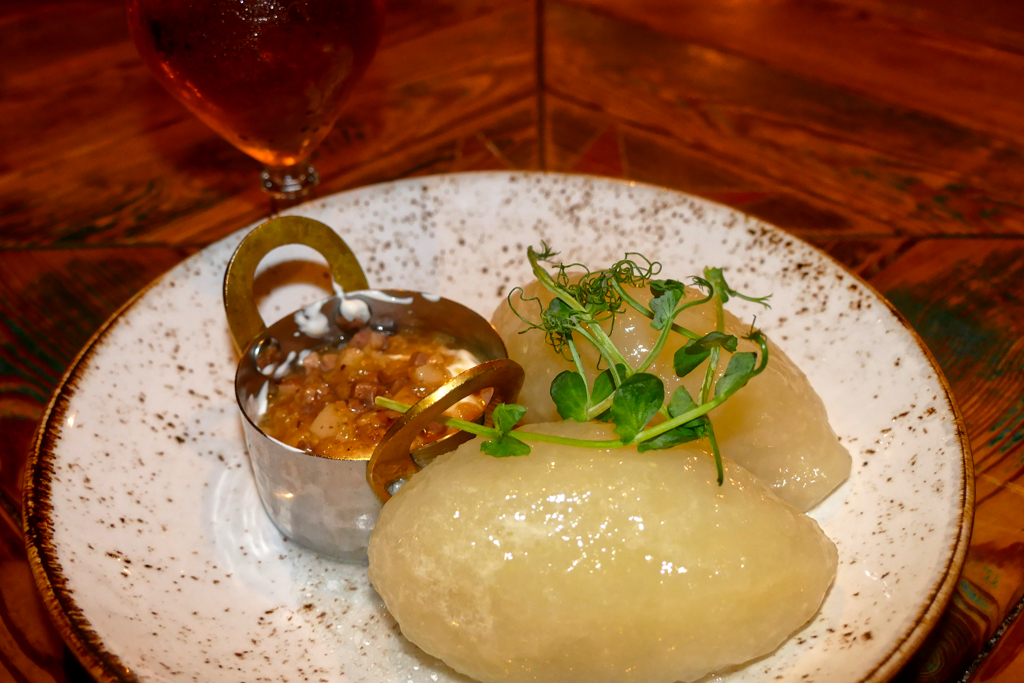
Key traditional foods include, first and foremost, Cepelinai. These large potato dumplings, named after zeppelins due to their shape, are typically stuffed with minced meat, cheese, or mushrooms. As if that’s not hefty enough, they are served with sour cream and bacon sauce. And those two supplements also elevate Kugelis, a baked potato pudding.
Skilandis is a type of smoked, dry-cured sausage made from pork and garlic.
A beloved staple is rye bread, a dense, dark, and slightly sour bread often served with butter, lard, and smoked cheese. Foraged mushrooms are an important ingredient in a country covered by dense forests. They are often added to soups and sauces.
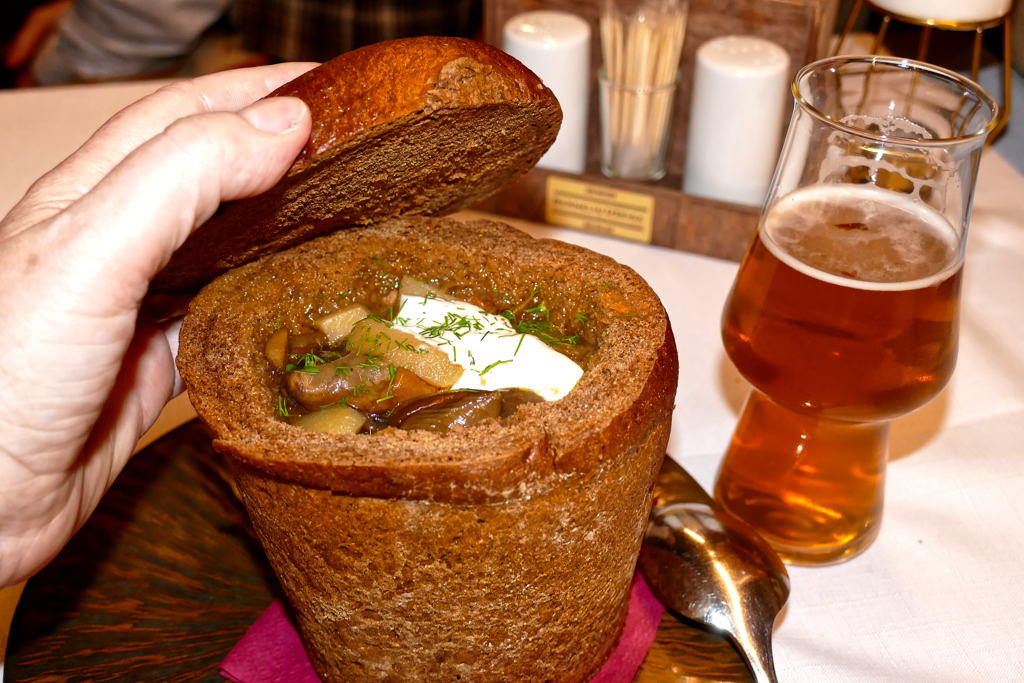
And now the colorful superstar of the Baltic cuisine: Šaltibarščiai! It is a brightly pink soup made with kefir, beetroot, and cucumbers. It is garnished with lots of dill and served with a boiled egg and potatoes. Obviously, it is especially popular in summer.
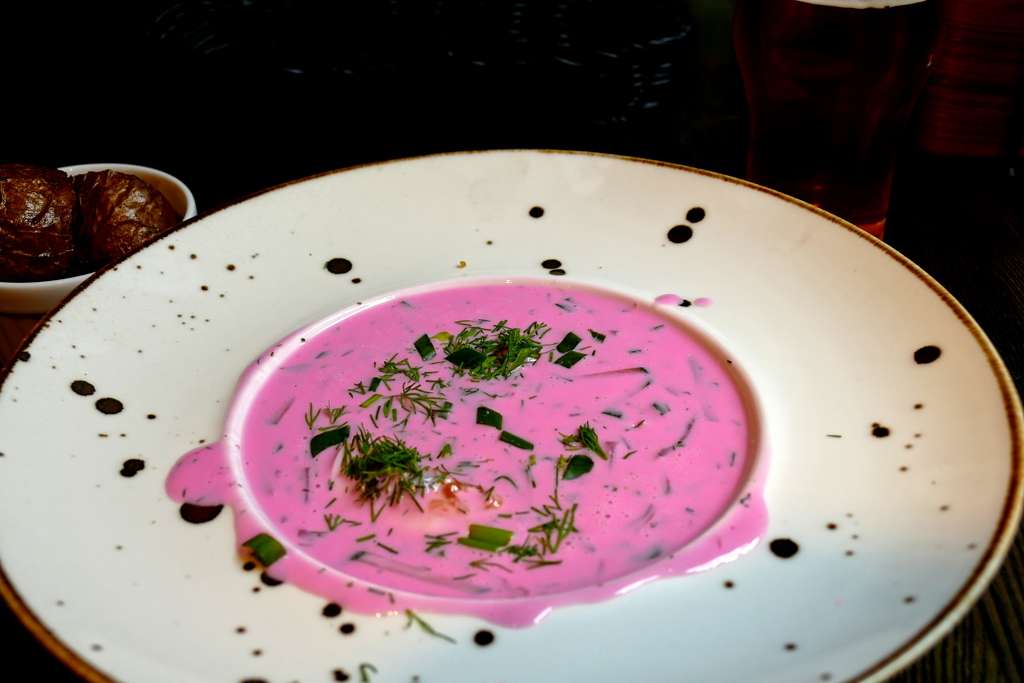
In fact, this soup is so popular that it’s celebrated with a lavish city festival every early summer. I, too, get swept along and dedicate a separate post to this extraordinary event: La Vie en Rose: How Vilnius Celebrates Soup with Exuberance.
Fusion
In recent years, Vilnius has seen a significant evolution in its food scene. Young chefs are reinterpreting Lithuanian classics using modern techniques and global influences, often focusing on local, seasonal, and foraged ingredients.
Many chefs, particularly in Vilnius, are embracing a new approach to traditional cuisine. They prepare it in a more minimalist, locally sourced, and most importantly, healthier way.

There is also an increase in vegetarian, vegan, as well as globally inspired dishes, such as Korean-Lithuanian mashups or sushi with Baltic fish.
Recently, craft beverages became a local staple. Local craft beer, mead, and small-batch liqueurs are thriving alongside wines and specialty coffee. In fact, the coffee scene is so impressive that I put together a list of the Best And Most Beautiful Coffee Houses in Vilnius.
Cash, Cards, And Deals
Until now, 20 European countries replaced their former local currency with the €uro starting in 2002. Lithuania was the last of the Baltic republics to introduce the €uro in 2015. The exchange rate is 1 US$ = 0.85 EUR as of July 2025. However, you can check today’s conversion rate on this page.
Cards and contactless payments are accepted basically everywhere.
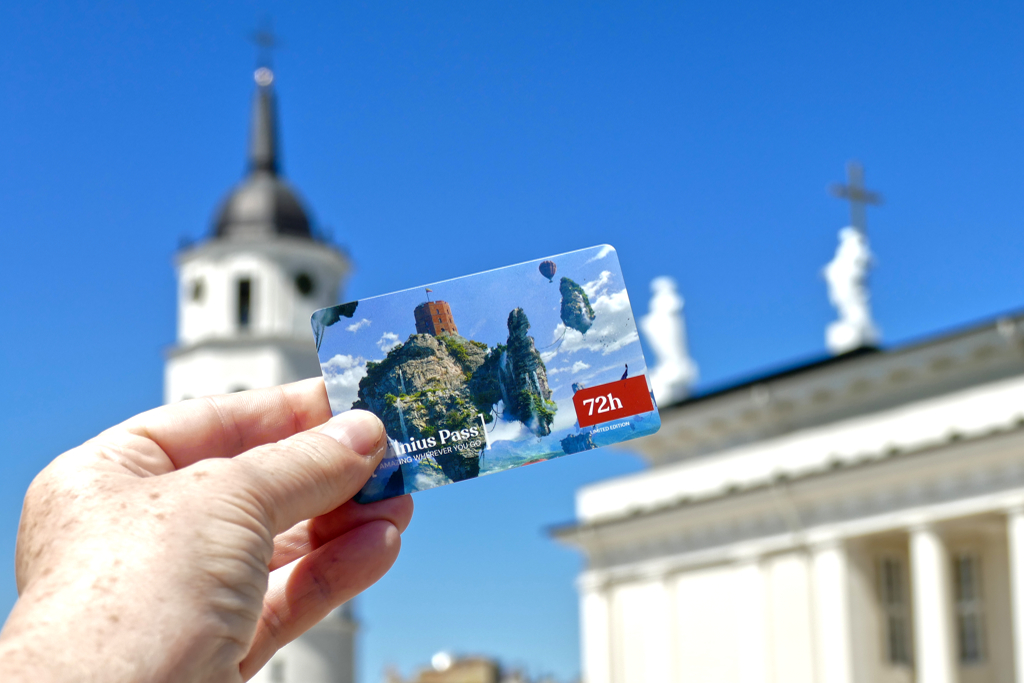
Entrance fees in Vilnius aren’t exactly neck-cutting, but it’s still worth saving a little here and there. And that’s where the Vilnius Pass* comes into the picture. It is the official sightseeing pass of the city and grants discounts or even free access to basically all major attractions in the city.
You can obtain the Vilnius Pass* already before your trip to Vilnius online and then activate it in their App on Android or iOS.
According to the length of your stay and your itinerary, you can obtain the Vilnius Pass* in three versions:
| 24 hours | 48 hours | 72 hours | |
| Vilnius Pass | 37 €uros | 47 €uros | 56 €uros |
Communication And Connection
Since June 2017, no roaming charges apply within the EU if you have a European mobile phone contract. This involves all 27 countries of the European Union as well as Iceland, Liechtenstein, and Norway.
The EU roaming regulation applies to all contracts.
In case European roaming is not available, you can connect to the internet at museums, eateries or cafés, and, of course, hotels.
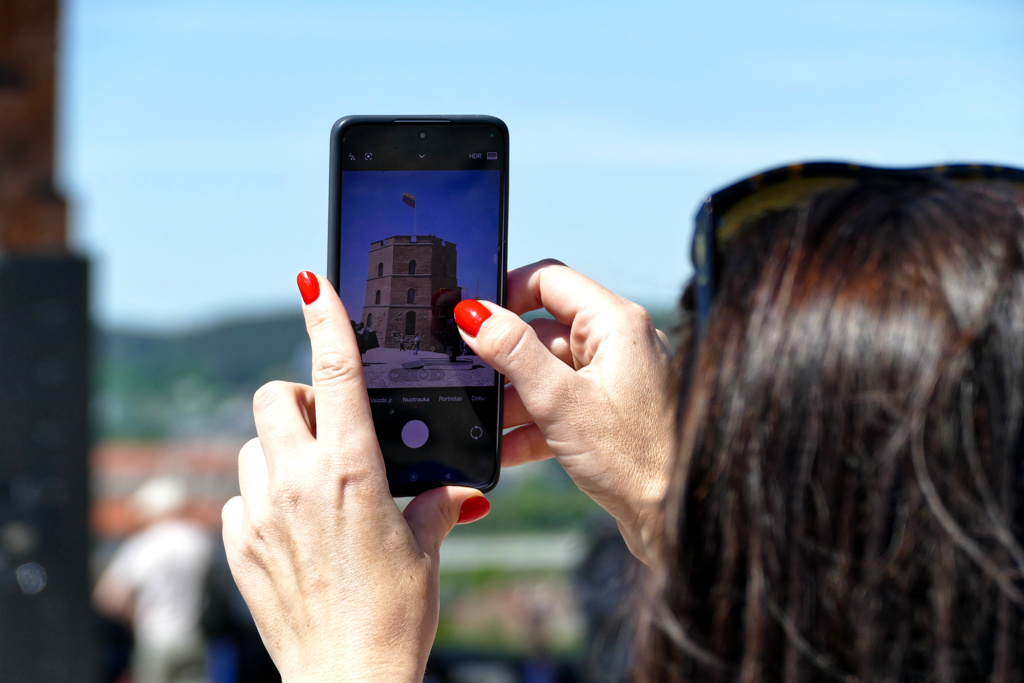
If you want to be online 24/7, you should opt for a SIM card. Lithuania offers several reliable and affordable SIM card options for visitors. Pildyk by Tele2 and Ežys by Telia are popular brands when it comes to prepaid SIM cards. You can obtain the cards at the company’s official stores. The people there will be able to assist you in English. Note that chain stores like Maxima, Iki, and Rimi sell starter packs. Either way, ensure your phone is unlocked before purchasing. Also, keep in mind that some SIM cards may require registration with a passport or ID.
For eSIM-compatible devices, consider digital options. Take into consideration that an eSIM from providers like SimOptions or ROAMLESS offers flexibility across multiple countries without the need to swap physical SIM cards.
The standard voltage in Europe is 230 V, and the frequency is 50 Hz. Whereby, nowadays, all these chargers have integrated adapters, in general, the voltage and frequency don’t really matter. In Lithuania, they use plug types C and F. By the way, you’ll find comprehensive travel info in my post World’s Most Complete Travel Information – an indispensable globetrotter classic.
Language
The official language of Lithuania is Lithuanian, obviously. It is one of the oldest and most well-preserved Indo-European languages still spoken today. Closely related to Latvian, Lithuanian belongs to the Baltic language family.
As Lithuanian is one of the oldest surviving languages in Europe, even linguists often study it to understand how early Indo-European languages evolved.
Seven noun cases make Lithuanian grammatically challenging for foreign learners.
Fortunately, English is widely spoken, particularly in major cities like Vilnius and Kaunas, and among younger people. Many older Lithuanians, however, speak Russian, though its use is declining.
The Polish minority in the Vilnius region speaks their mother tongue, obviously.
Fun Fact:
Lithuanian is so archaic that some words closely resemble Sanskrit, an extinct classical language of India!
Map
On this map, you see where to find the most amazing buildings that make Vilnius the proverbial Pearl of the Baltic. Clicking on the slider symbol at the top left or the full-screen icon at the top right will display the whole map, including the legend.
So yes, these are some of the best things to see on an unforgettable weekend in Vilnius. If you want to dive deeper into the glorious Baroque past of the city, check out my post Vilnius Baroque: The City’s Twelve Most Magnificent Churches. Then, in my post Best And Most Beautiful Coffee Houses in Vilnius, I’m introducing the 15 most alluring coffeehouses for a formidable break during your sightseeing.
If urban art is your jam, make sure to check out the comprehensive post on Best Street Art in VILNIUS. In my post La Vie en Rose: How Vilnius Celebrates Soup with Exuberance, I’m inviting you to join the fun during Vilnius’ annual Pink Soup Fest.
Pinnable Pictures
If you choose to pin this post for later, please use one of these pictures:
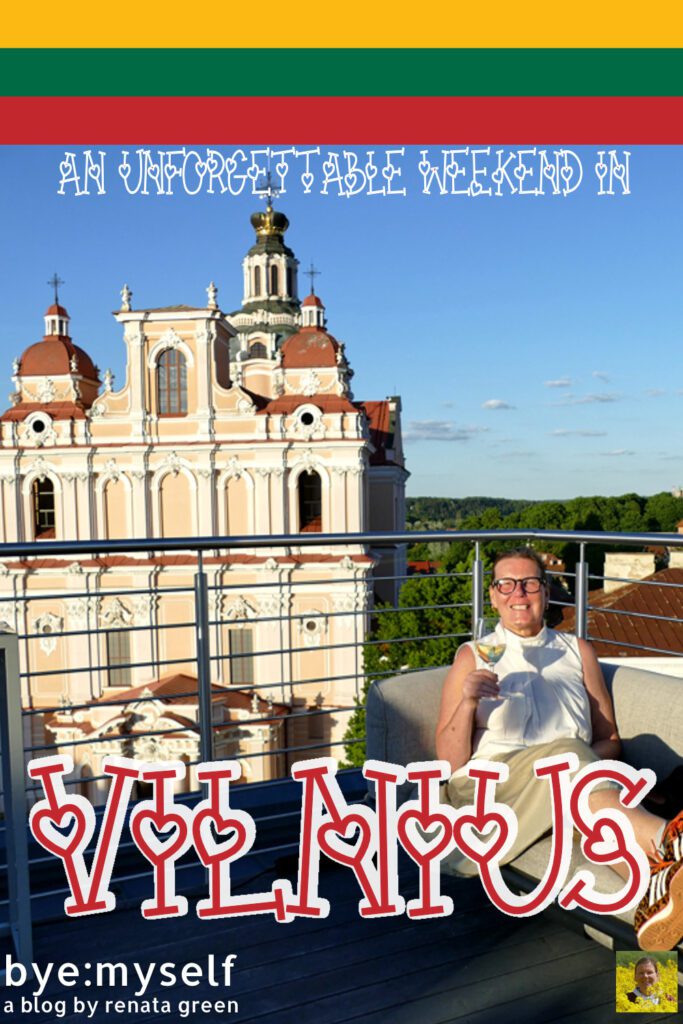
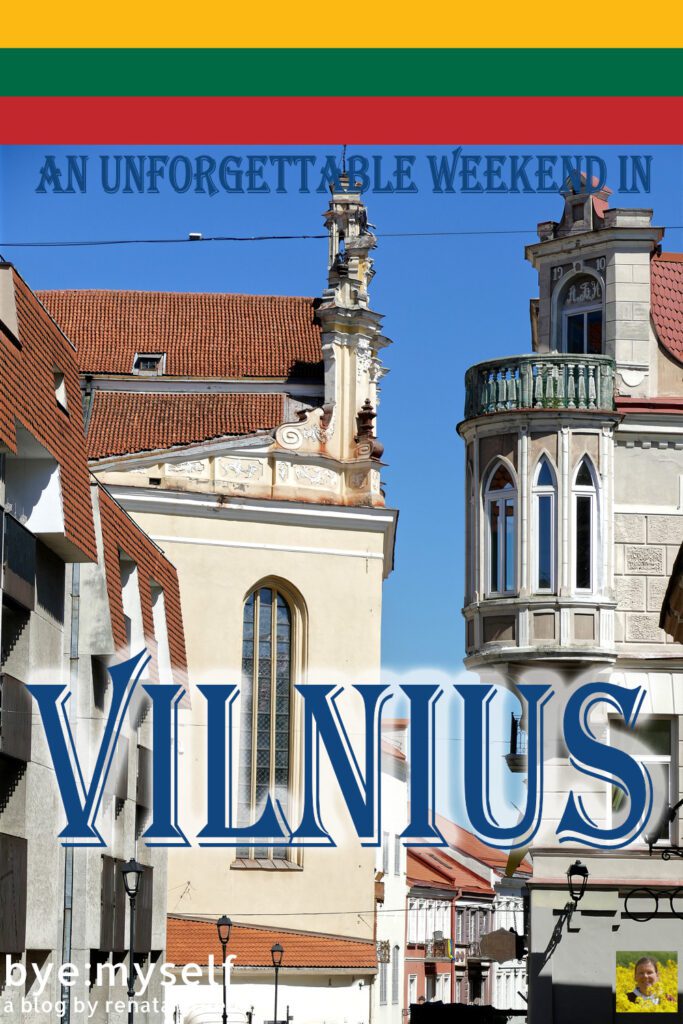
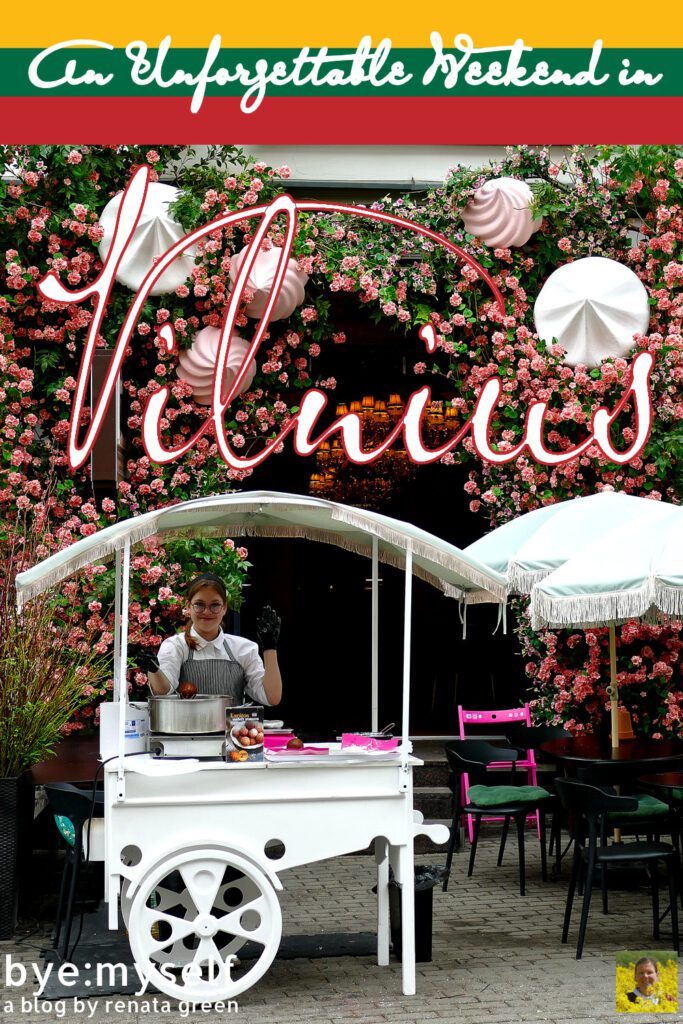
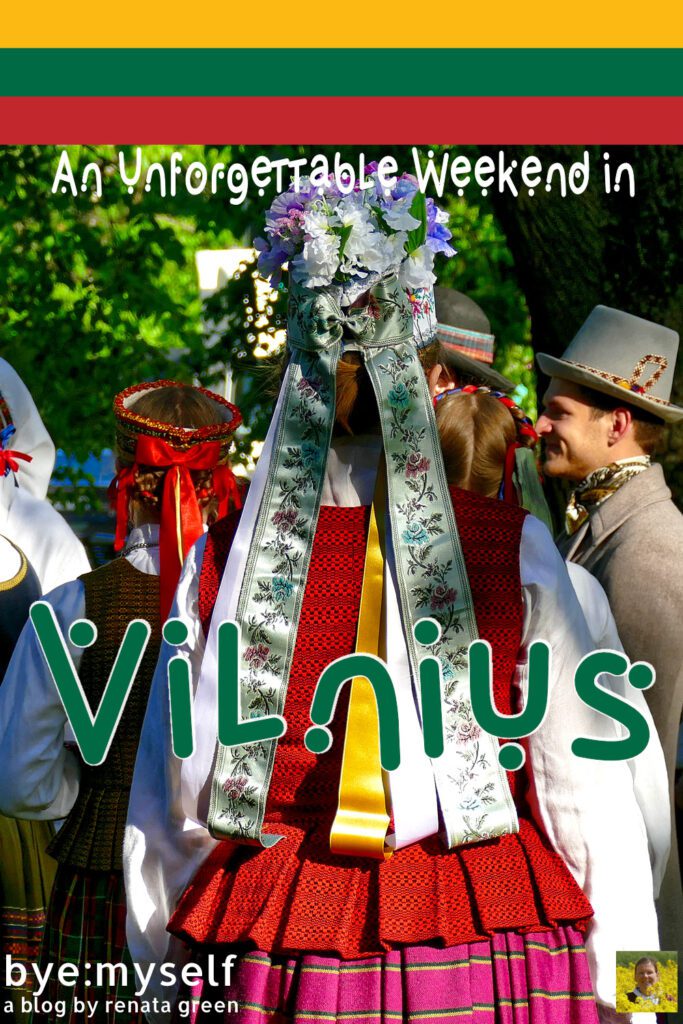
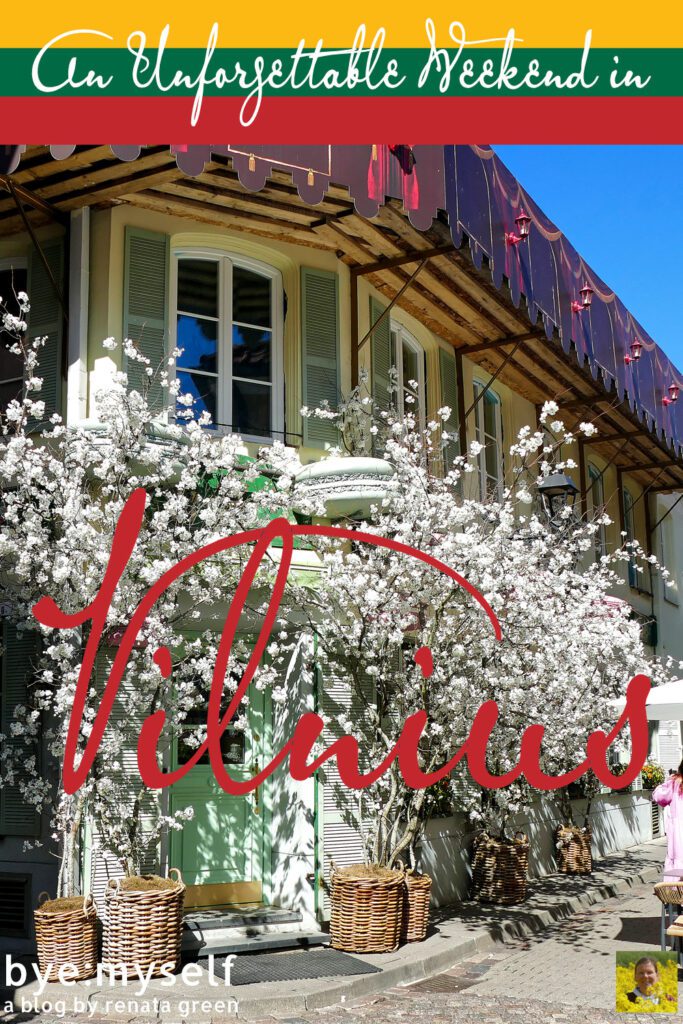
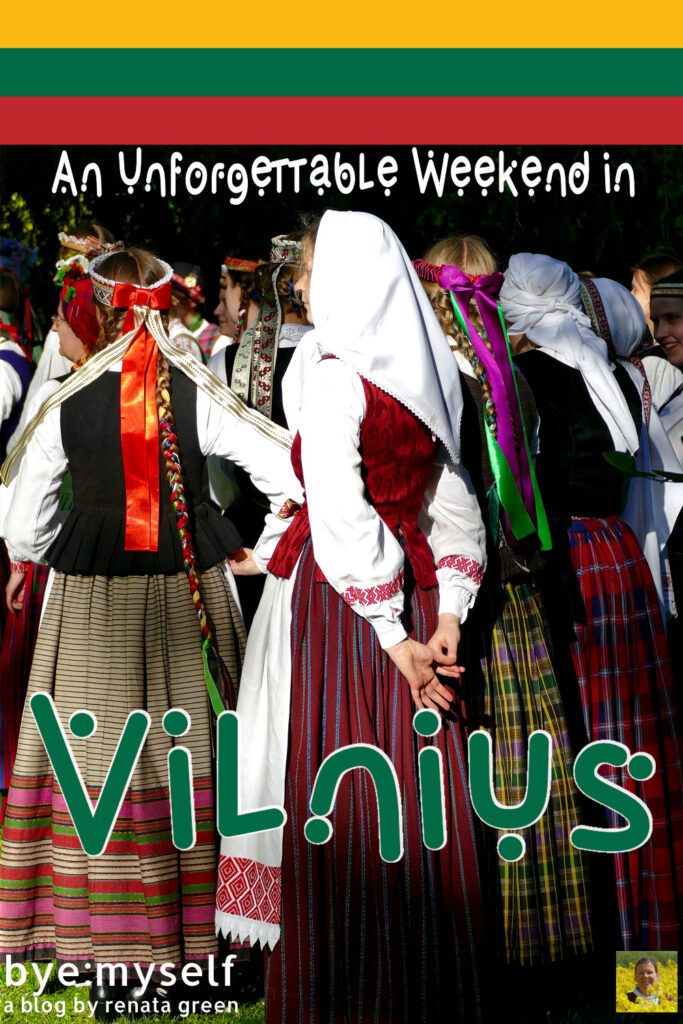
Did You Enjoy This Post? Then You Might Also Like These:
Comprehensive Guide to TALLINN – a City Between the Poles of History and Creativity
A VAN-TASTIC TRIP to the ISLAND of FEHMARN
Best And Most Beautiful Coffee Houses in Vilnius
Best of RIGA – a Guide to Latvia’s Entrancing Capital
What to See on an Unforgettable Weekend in VILNIUS
LUBECK – a guide to Germany’s most ravishing city
La Vie en Rose: How Vilnius Celebrates Soup with Exuberance
ISLAND HOPPING in GERMANY
Disclaimer: * I was invited to stay at the Radisson Collection Astorija Hotel. Also, Go Vilnius supported my blogger trip by supplying me with a 72-hour Vilnius Pass. However, all opinions on these services are mine and weren’t by any means influenced by my cooperation partner.
** This is an affiliate link. If you book through this page, not only do you get the best deal. I also get a small commission that helps me run this blog. Thank you so much for supporting me!



